STEM Activities for Primary School Children (6-11 years)
By Dr Jennifer Martay, PE
Course Leader for Medical Engineering at Anglia Ruskin University
I am a Biomedical Engineer with 3 young children. This page suggests games, kits, and activities to teach STEM skills to primary school children (6-11 years). Find out my top 5 STEM activities for Primary School Children in this video!
S: Science
At this age, Science focuses on hands-on activities that promote interest in and knowledge of biology, chemistry,
physics, and environmental science. Most of these activities use kits, which can be cheaply bought from charity
shops or from online second-hand sales.
-Science Project Kits. Books of science experiments are cheaply available at almost every charity shop. The
books propose a range of science projects investigating different topics. There are also many websites with proposed
projects - for example, Science Sparks. Many charity shops also have
science project kits (such as KidzLabs) available for a cheap price. If you buy a second-hand kit, make sure all of
the pieces are in the kit and till useable.
Pros: Free experiments to suit every child's interests.
Cons: Make sure kits are complete and usable before buying!
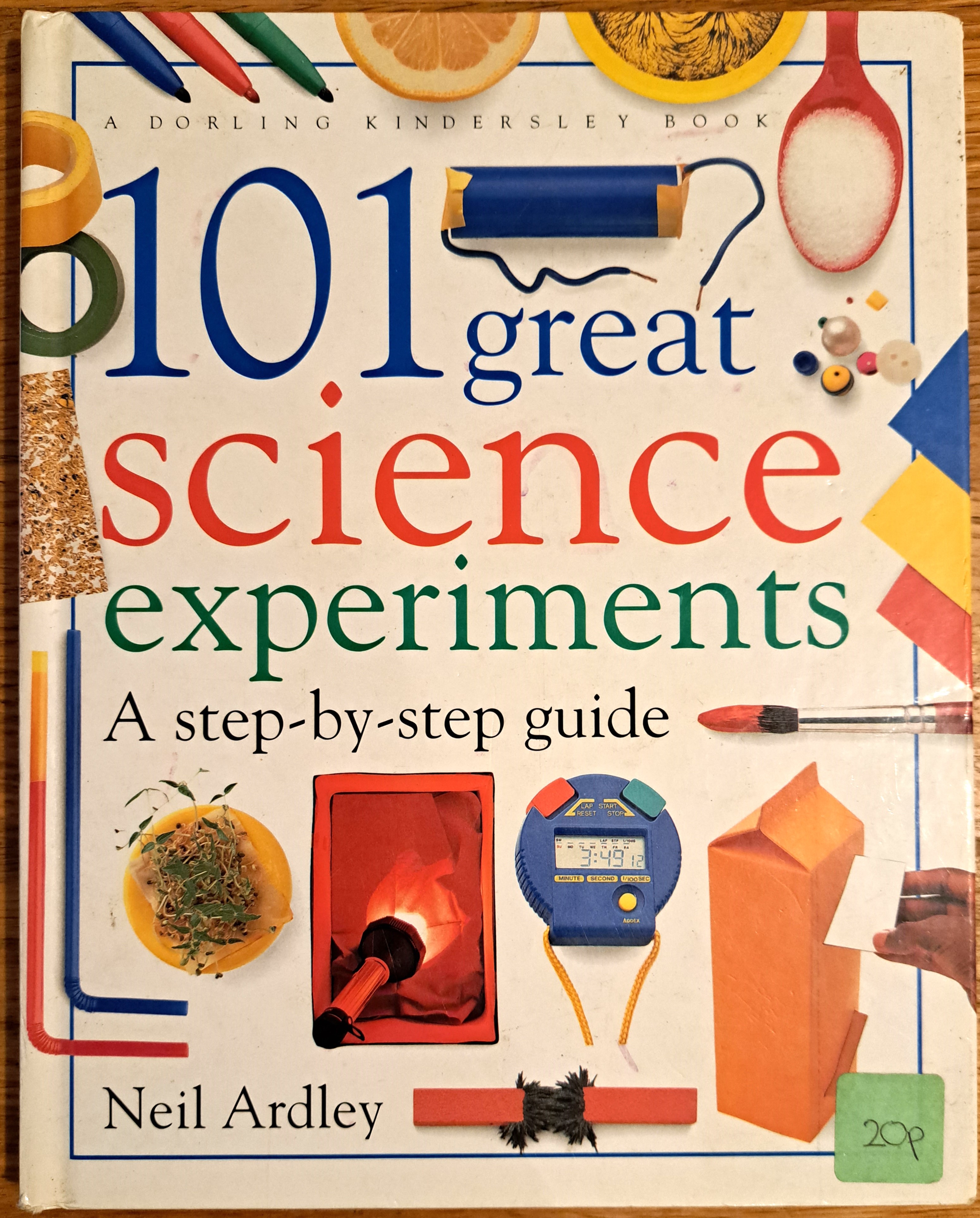
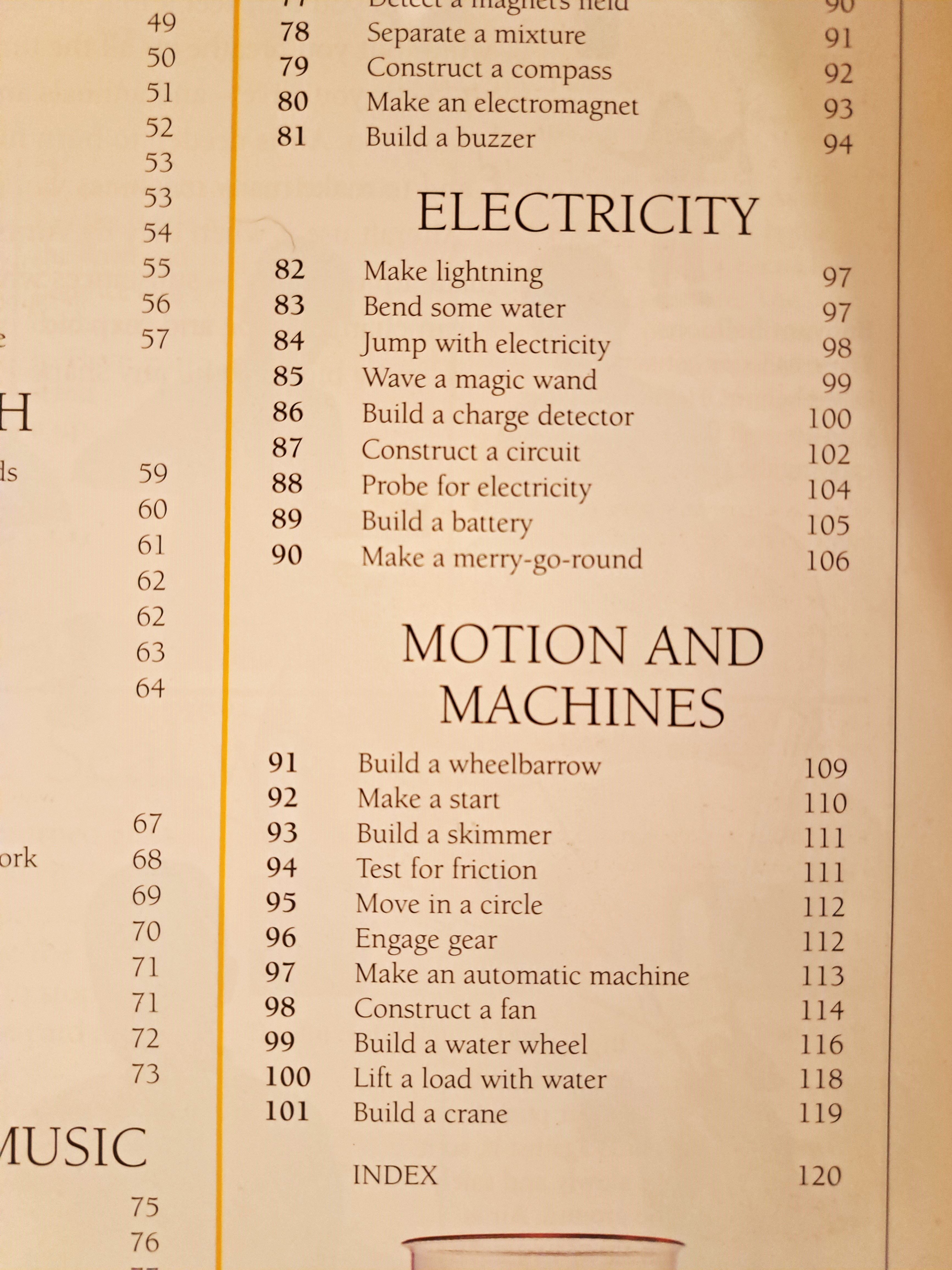
-Electronics Kits:
"Snap Circuits"/"Primary 2 Electronics Kit" from Cambridge BrainBox.
Players: 1+
Recommended ages: 8-11 years
Time to play: 20+ minutes
Paid: £1 from charity shop
Kit comes with different components (speakers, LEDs, flying wheel/motor, reed switch, etc) and an instruction manual
that shows and tells you how to put together different circuits. The manual is great for kids who like following
step-by-step instructions (or adults who aren't as comfortable with electronics). My kids never followed the manual
and preferred building whatever they wanted and troubleshooting.
Pros: Manual very easy to follow. Circuits do fun things - play songs, light up LEDs, shoot off spinning wheel. Easy
to find cheaply from charity shops or second-hand sales. Pieces snap into place which makes it easier to keep circuit
together. Kids can play independently.
Cons: We have blown out the fuses multiple times and needed to get new ones (but this is the job of the fuse!). Expensive
if bought new.
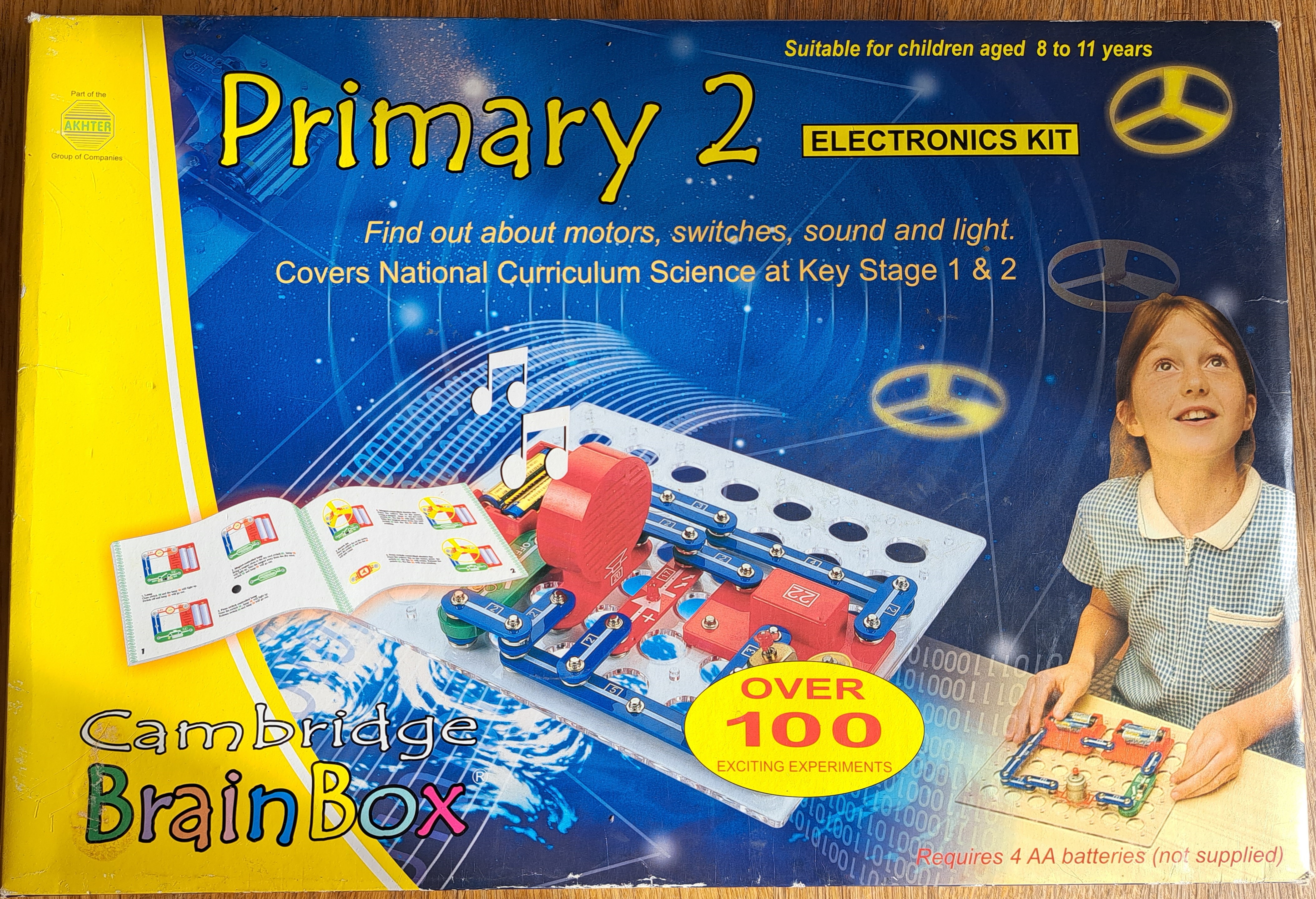
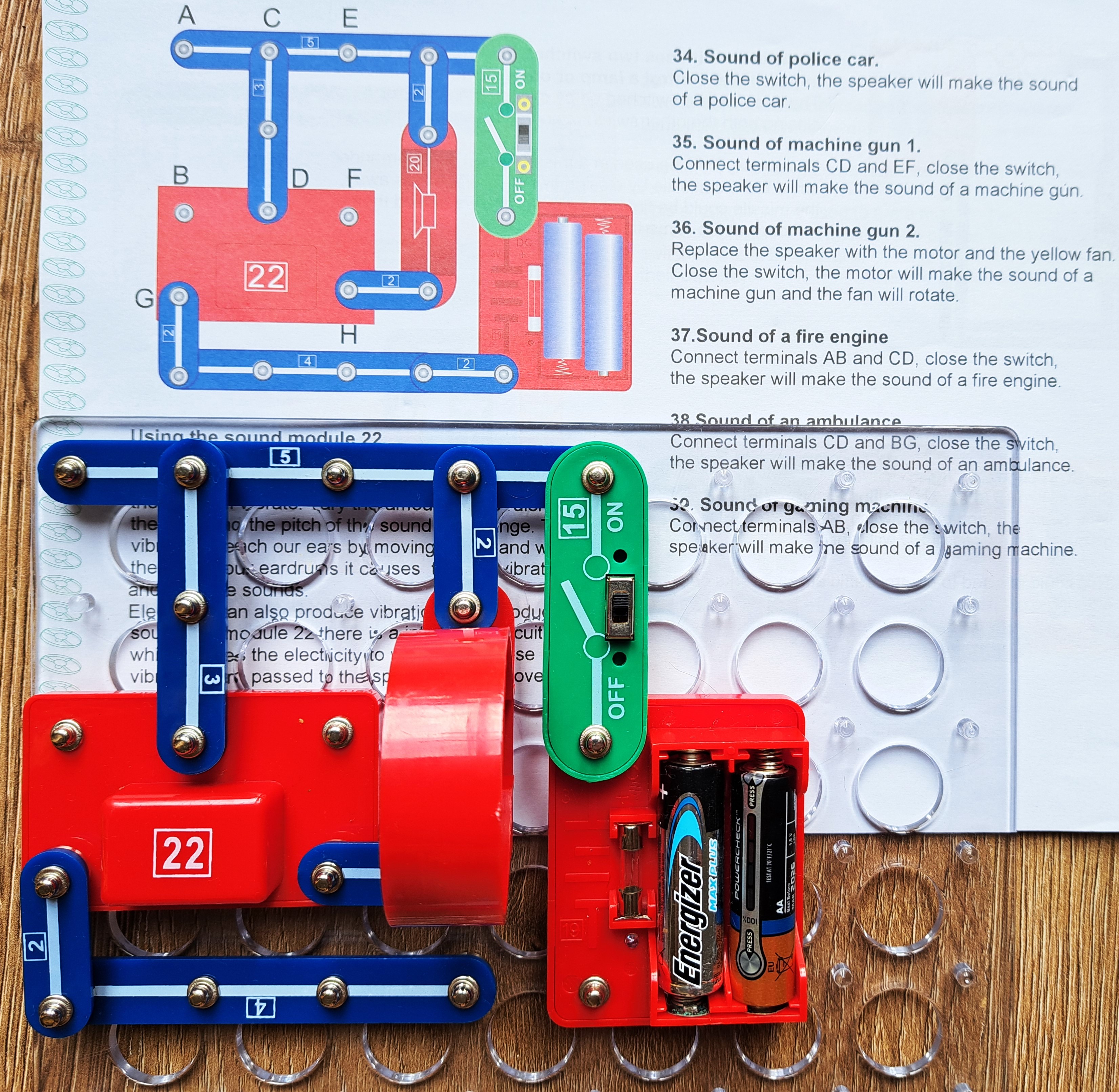
-Make Your Own Volcano/Rocket. Mix vinegar, water, washing up liquid, and food coloring with baking soda inside a soda bottle.
If you put the soda bottle in something that looks like a volcano, you have an erupting volcano. Put some wings on
the bottle and turn it upside down and you have a rocket! There are many variations of this experiment! Experiment
can also be extended: experiment with different proportions of ingredients to investigate effect on volcano/rocket.
Pros: Likely already have materials so minimal associated cost. Exciting to watch baking soda and vinegar mix and
bubble! Can double activity as an art project creating the volcano or rocket structures.
Cons: Rocket can fly into neighbor's yards or into you - be careful where you point the rocket! Some clean-up required.
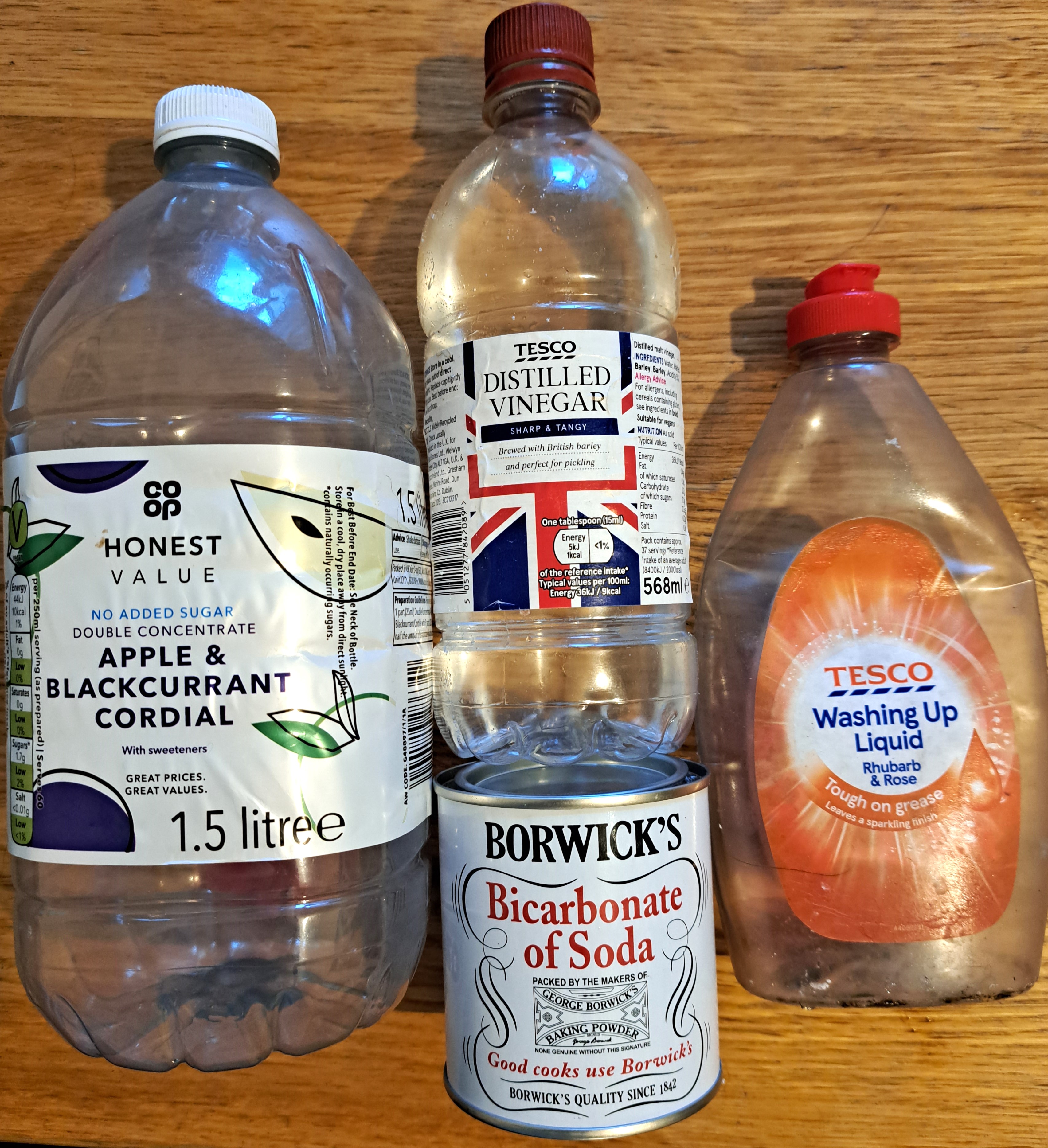
-Make Your Own Solar System:
"Glow in the Dark 3D Solar System" from Great Explorations.
Players: 1
Recommended ages: 5+ years
Time to play: 30 minutes
Paid: £16 new from Argos
This kit has 3D plastic models of each of the planets. The planets have their distinguishing characteristics
(Saturn's rings, Jupiter's spot, etc). Each planet also has a plastic hoop so that the planets can be hung from a
string in their correct relative location within the solar system. A nice addition, the planets are also glow in
the dark!
Similar kits are also available elsewhere. In some of these, the planets are polystyrene spheres that can be colored
in and stuck on rods in their correct relative locations within the solar system.
Pros: Easy kit to hang up. Accurate characteristics on the planets. Fairly robust planets (withstood a lot of playing
before they broke).
Cons: Planets need to be in the light for quite some time before they glow in the dark.
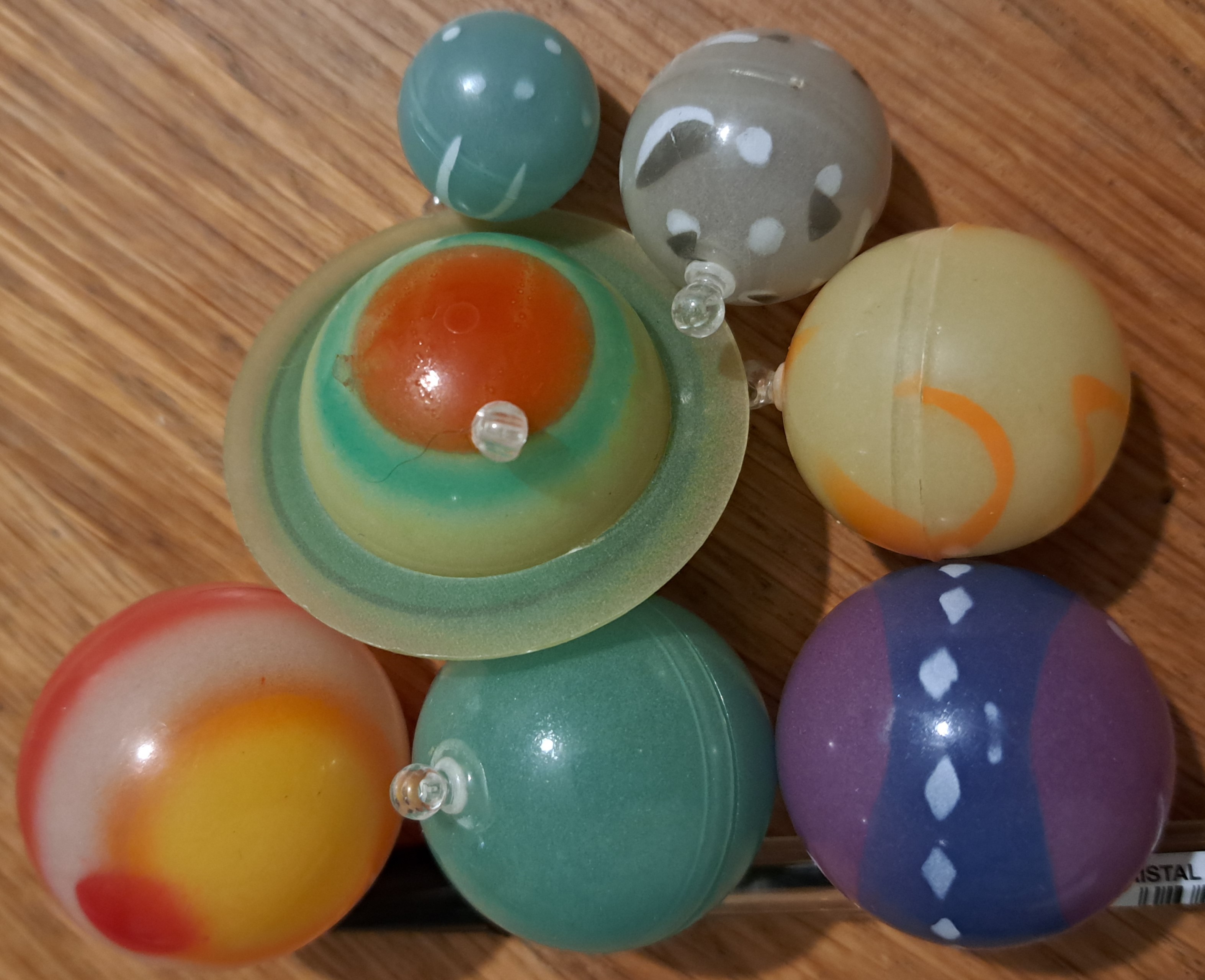
-Explore/Chart Star Constellations and Planets. Download Sky Map app onto phone and point phone in any direction.
The app shows and names the planets and stars the phone is pointed at (even showing planets/stars only seen on other
side of Earth). You can save screenshots from the App and draw in the constellations later.
Pros: Free app from Google Play ("Sky Map"). Identifies planets and stars any time of day (not just when dark) and in
both hemispheres.
Cons: Would be nice to have an option to have constallations drawn in over stars.

-Local/National Science Festivals, Planetarium, and/or London Science Museum. Learn about science through hands-on, interactive exhibits.
Pros: Huge variety of topics to explore. Can attend multiple times and still learn new things. Exhibits usually very
engaging. Generally free admission.
Cons: Need to travel to museum. May have limited opening hours.
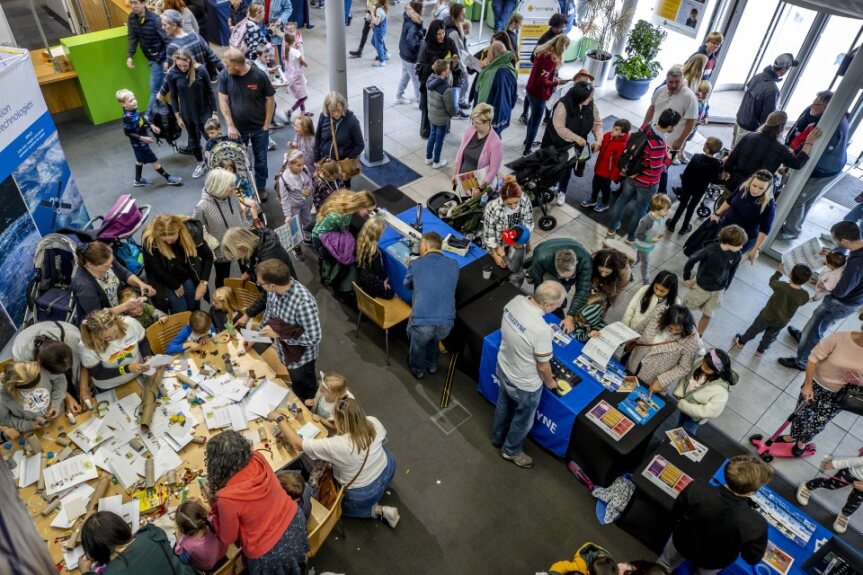
T: Technology
At this age, Technology focuses on using fine motor skills to build structures and increasing familiarity
with specialist equipment. Activities to practice building skills can often be found in charity shops or
online second-hand sales. Specialist technology may need to be purchased new.
-Build Your Own "FM Radio" from Eight.
Players: 1+
Recommended ages: 14+ years
Time to play: 4-5 hours
Paid: £20 online
This kit contains everything (other than a 9V battery) you need to build an FM radio. Each step is clearly
explained in an instruction manual, with pictures showing where each component needs to go. The radio worked
surprisingly well. The radio kit says it is for children 14+ years but I believe a 10-11 year old could probably
construct the kit with significant adult supervision.
I thought this was a brilliant kit - and my 5 year old enjoyed me explaining how a radio works to him. For this
age range and most children, the radio kit should probably be built by an adult. A primary school child would enjoy
learning about how a radio works and what the components are called and do. A very advanced primary school child
might be able to built the kit with significant help from an adult.
Pros: Great introduction to electronics. The manual explains what each component is called and does - and shows
step-by-step how to built the radio. Kids like listening to the radio after - a tangible thing to build! Many similar
kits required soldering - this kit does NOT require soldering.
Cons: £20 is an investment, albeit a relatively small one for an electronics set. It can be difficult to strip the wires
and place them (there are a lot of wires on the bread board by the end)!
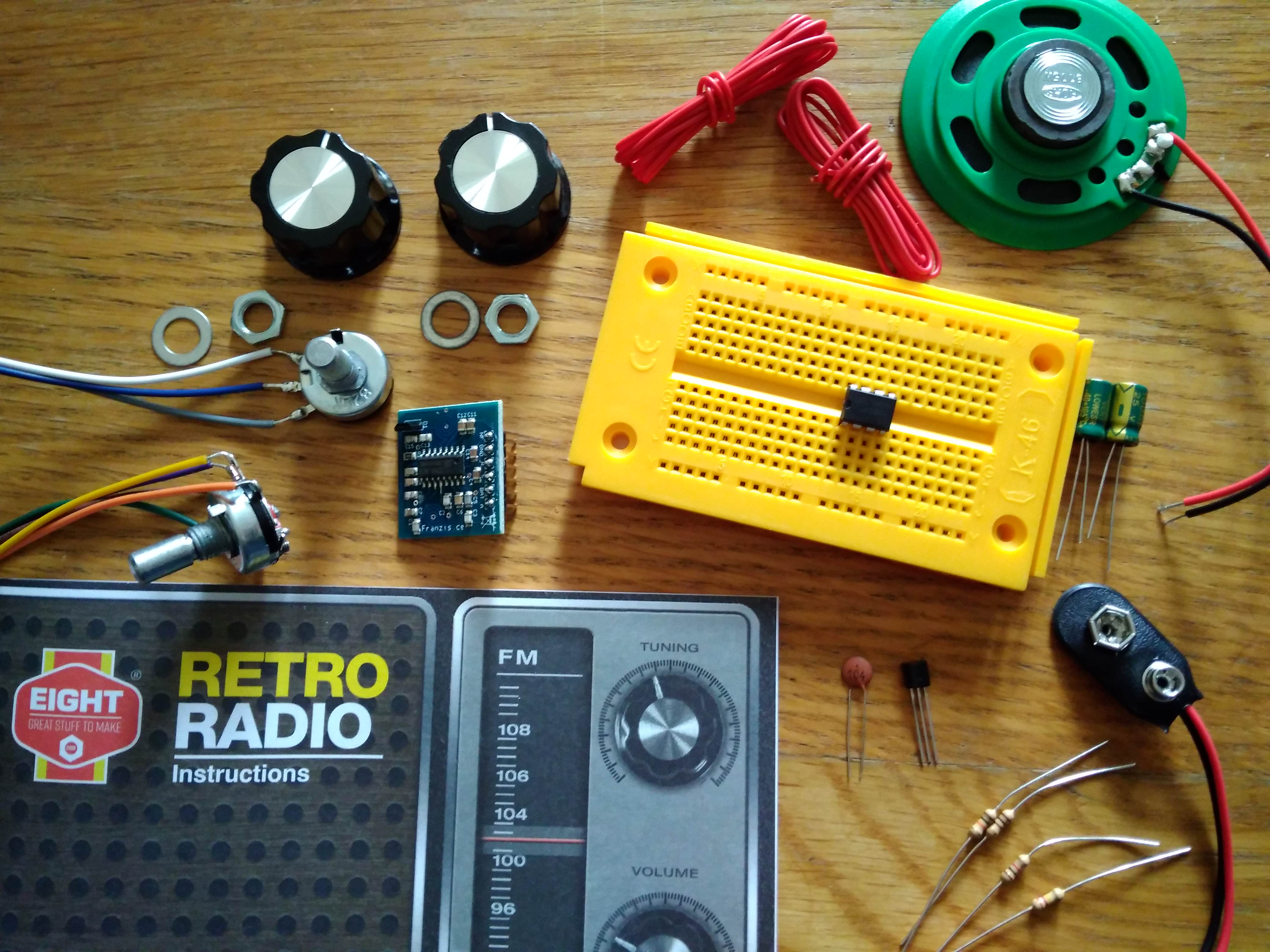
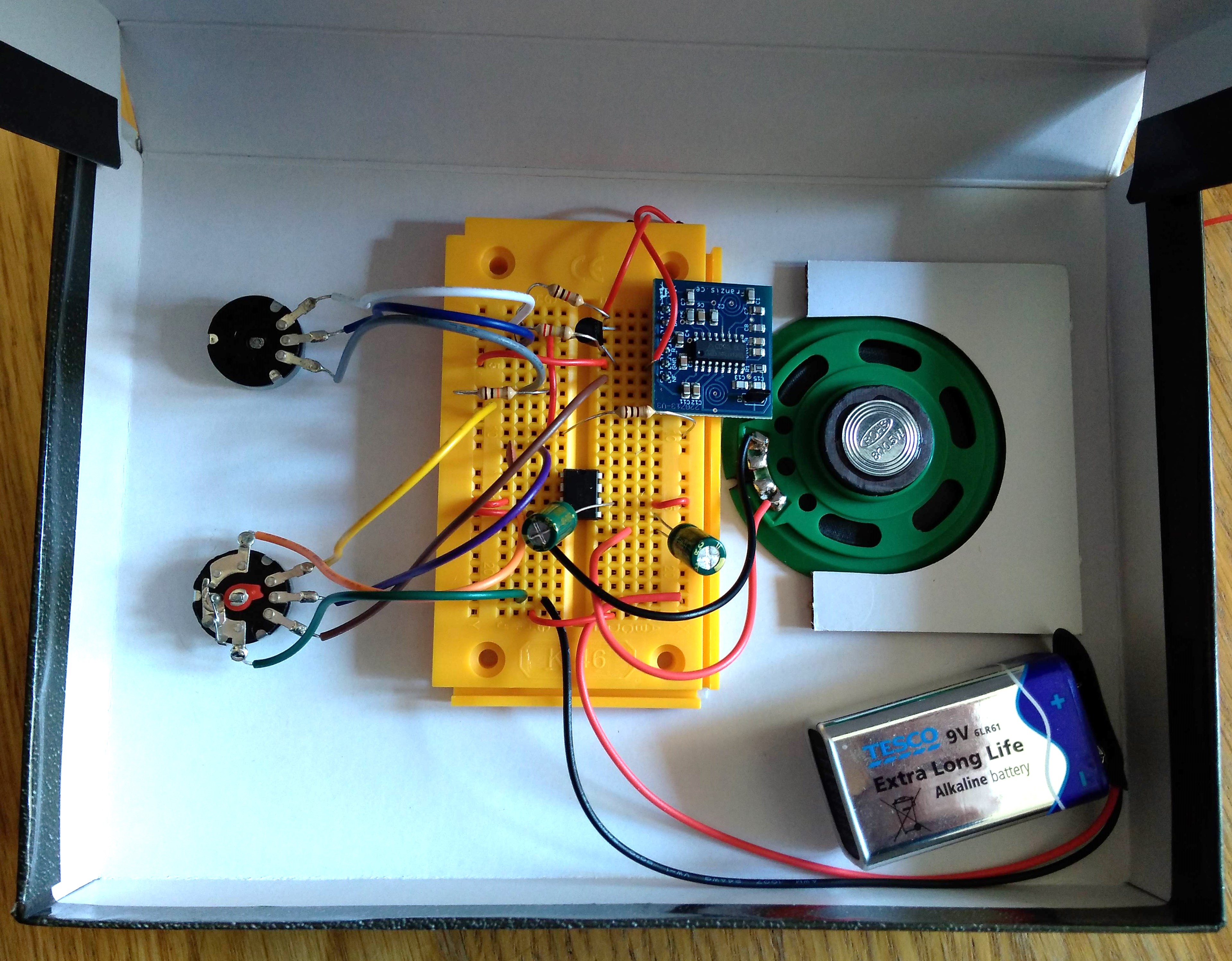
-Use a
"USB Digital Microscope" from Jiusion to Investigate the World.
Players: 1+
Recommended ages: No age listed
Time to play: 30+ minutes
Paid: £19 from Amazon
This USB Digital Microscope is small, light-weight, and plugs directly into your laptop or phone. Under heavy adult
supervision, we allowed our 3 and 5 year olds to investigate fine details of coins, fabric, dust, leaves, hair, feathers,
insects, etc.
A primary school child would be able to use this with adult supervision. The kids loved looking at small level
details - as did the adults! You can create pictures of what you see in the microscope to view later.
Pros: This is probably one of the best "toys" we have ever bought. The kids loved it. We loved it. I used it in
our university to investigate biomimicry and potential advances in building surveying - and our students loved it.
It's such a powerful microscope for such a low price. A definite buy in my opinion!
Cons: In our family, we had arguments over who would play with the microscope first, and who had had it for a longer
time..... We found some Apple phone users struggled to get the microscope to work on their phone.
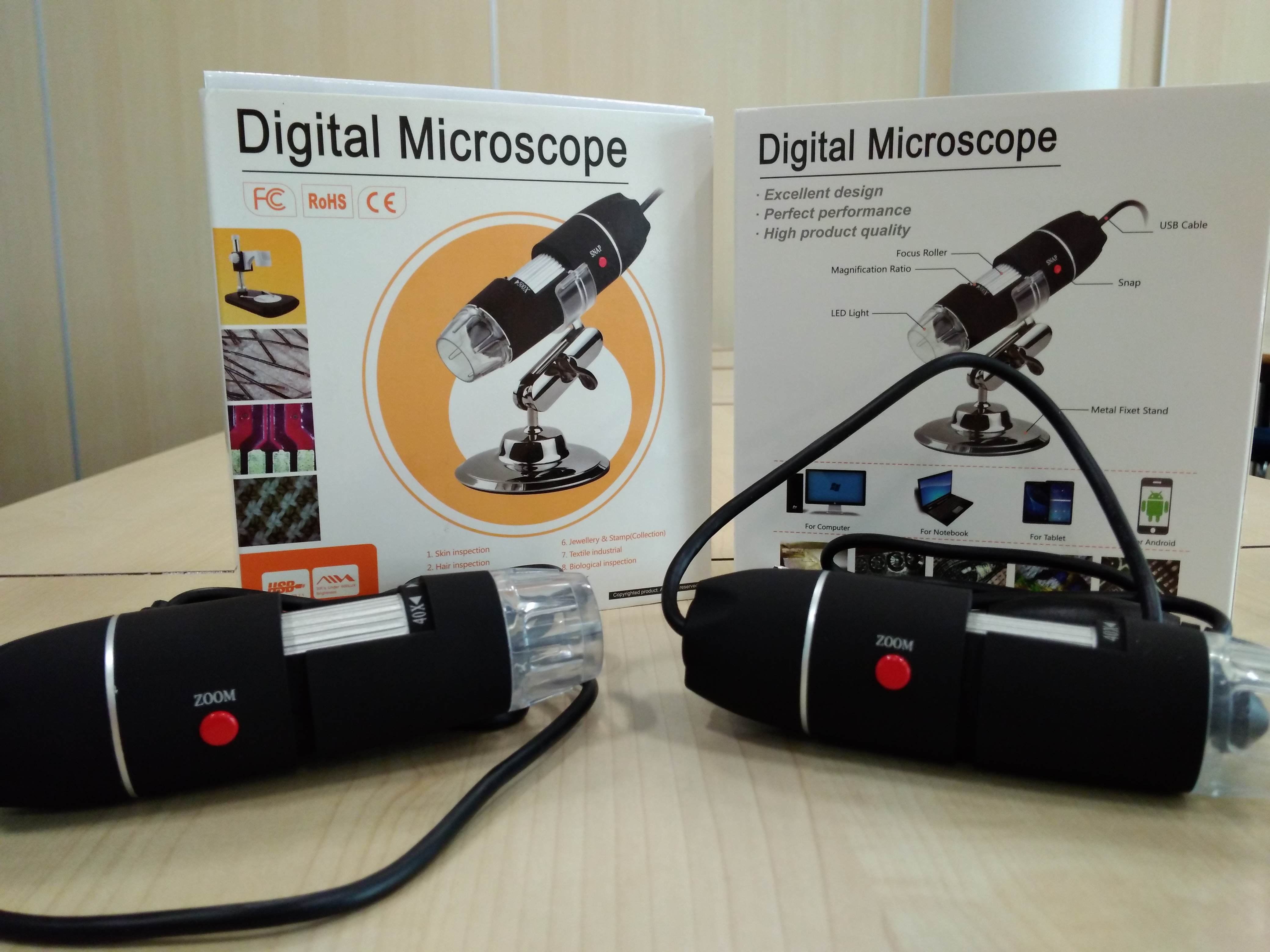

-Use "My Discovery Telescope" from Thames & Kosmos to Look at Space.
Players: 1+
Recommended ages: 6+ years
Time to play: 10+ minutes
Paid: Free from neighbor having a house clear-out (£19 new from Amazon)
We found this telescope free from a neighbor so I'm not sure what brand it is, but it is similar to "My Discovery
Telescope". The kids liked adjusting the knobs to change the telescope's focus and looking close-up at objects
within the house. We tried the telescope outside at night but we weren't successful in seeing anything very clearly.
Pros: Free telescope so we gave it a try. Kids got familiar with how telescopes work - and liked playing with
a "big people toy".
Cons: Telescope didn't actually work - but maybe this is why the neighbor was throwing it out. A new telescope
might have worked at night-time.
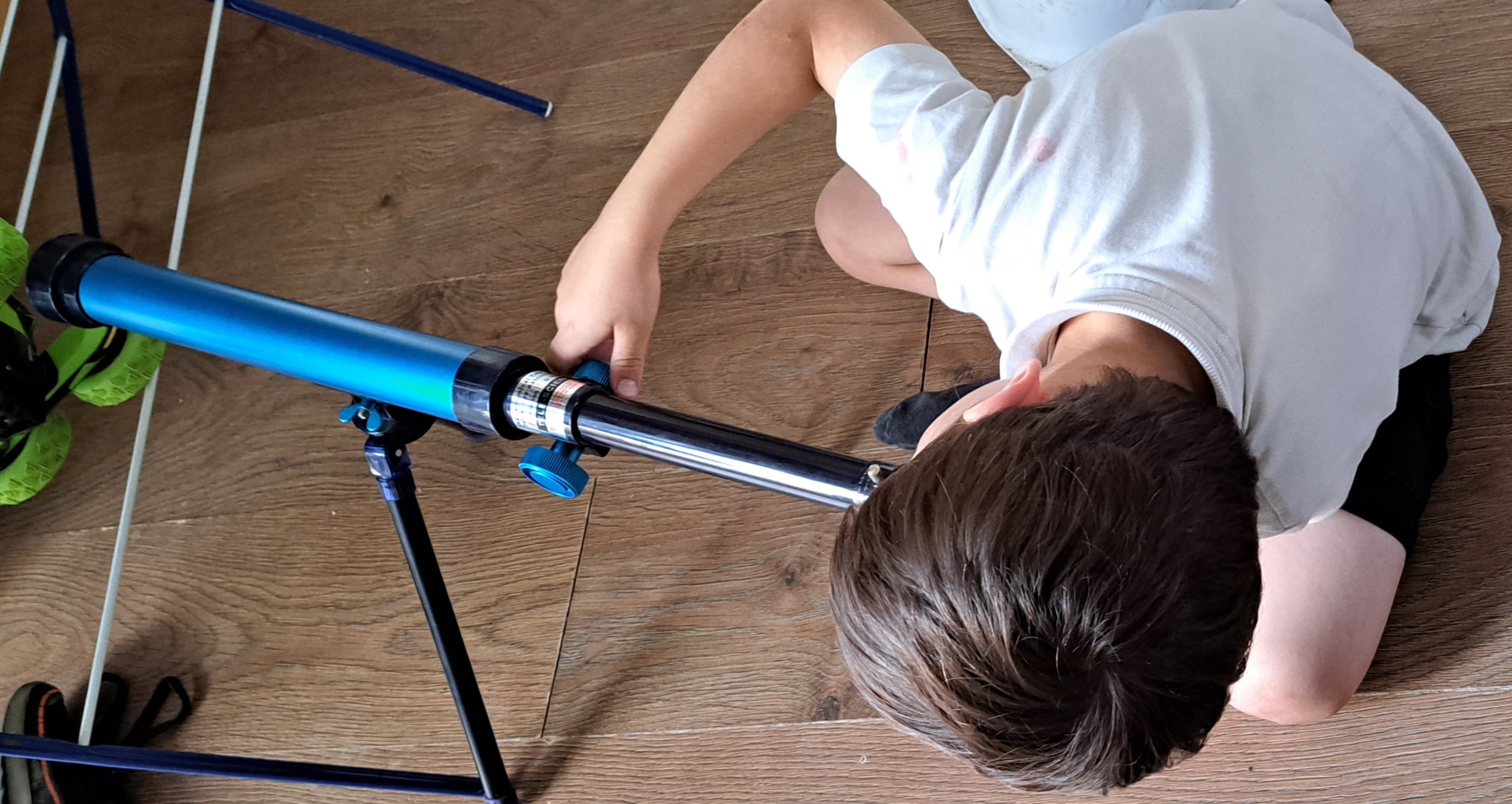
-Use Computers/Laptops to Learn Basic Computer Skills. Explain to kids the difference between files and folders.
Let kids practice using keyboard arrows and space bar, perhaps in online computer games for kids. Have kids practice
typing to gain keyboarding skills. Show kids how to edit pictures and videos. Ideally, kids would practice with an
older laptop in case anything is damaged. There are kids versions of laptop (Leap Frog) that also teach familiarity
with some of these computer skills.
Pros: The ability to confidently use a computer will be vital for our children. Kids love using "big people" things.
Kids will love playing online kids computer games with adults.
Cons: Need adult supervision to ensure laptop/computer does not get broken.
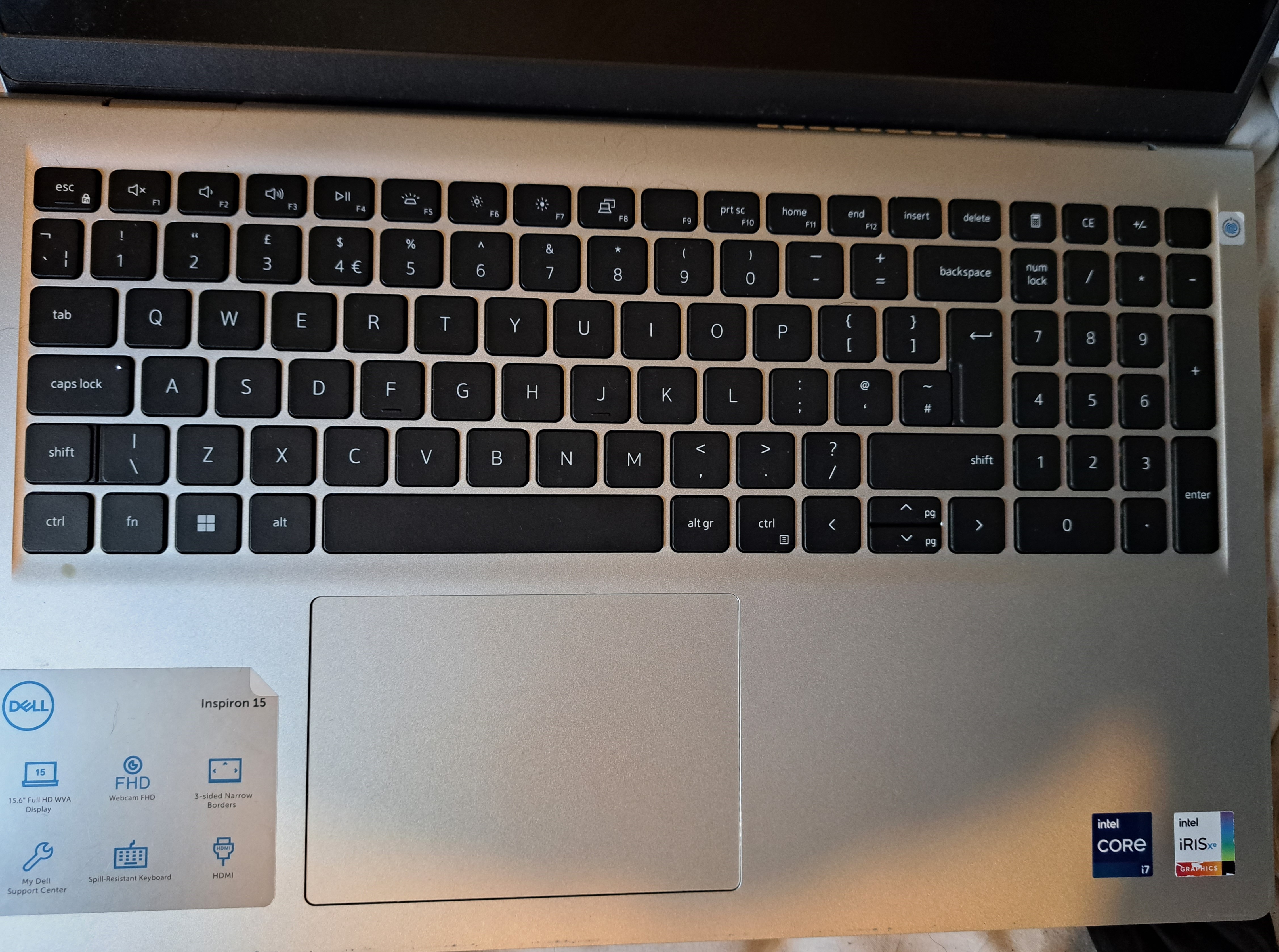
-
"Starter Set XXL" from Gravitrax.
Players: 1+
Recommended ages: 8+ years
Time to play: 20+ minutes
Paid: £10 from second-hand sale (£110-£200 new)
The Starter Set XXL has loads of components (ramps, curves, straight-overs, loop-the-loops) for your marble to
run through. A selling point of Gravitrax is that it doesn't require a battery. Gravity pulls the marble
down - so the heights of your towers are important as they affect the speed of the marble.
Pros: Kids gain understanding of height (potential energy) translating into speed (kinetic energy). This
particular kit has some more fun obstacles the kids enjoyed.
Cons: Very expensive if bought new. My kids and I thought this was "ok" on the fun scale and much preferred
marble run. Marble is choking hazard for younger kids. Someone bought us the expansion set before we had the base,
which meant we could not do much at first.
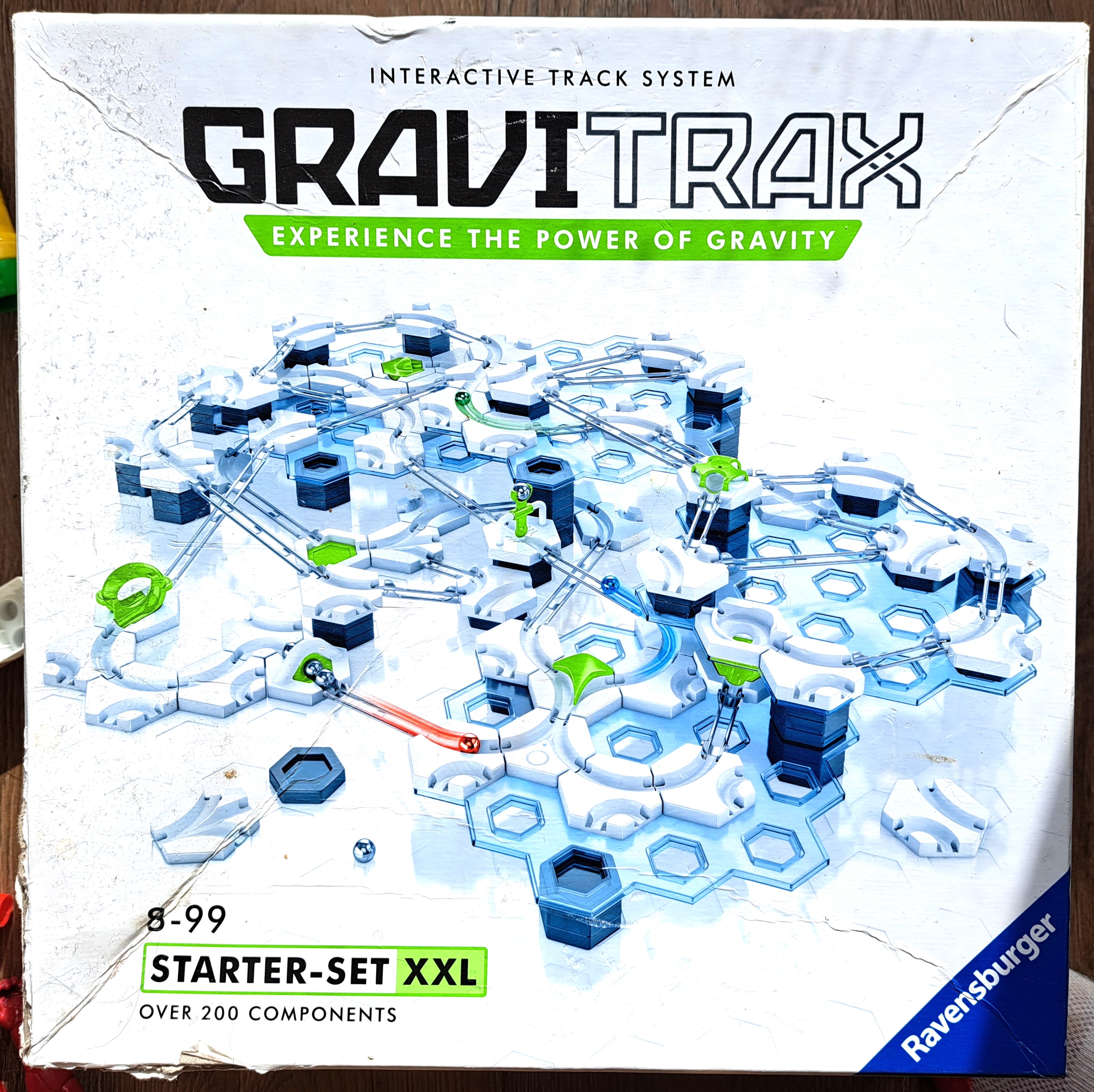
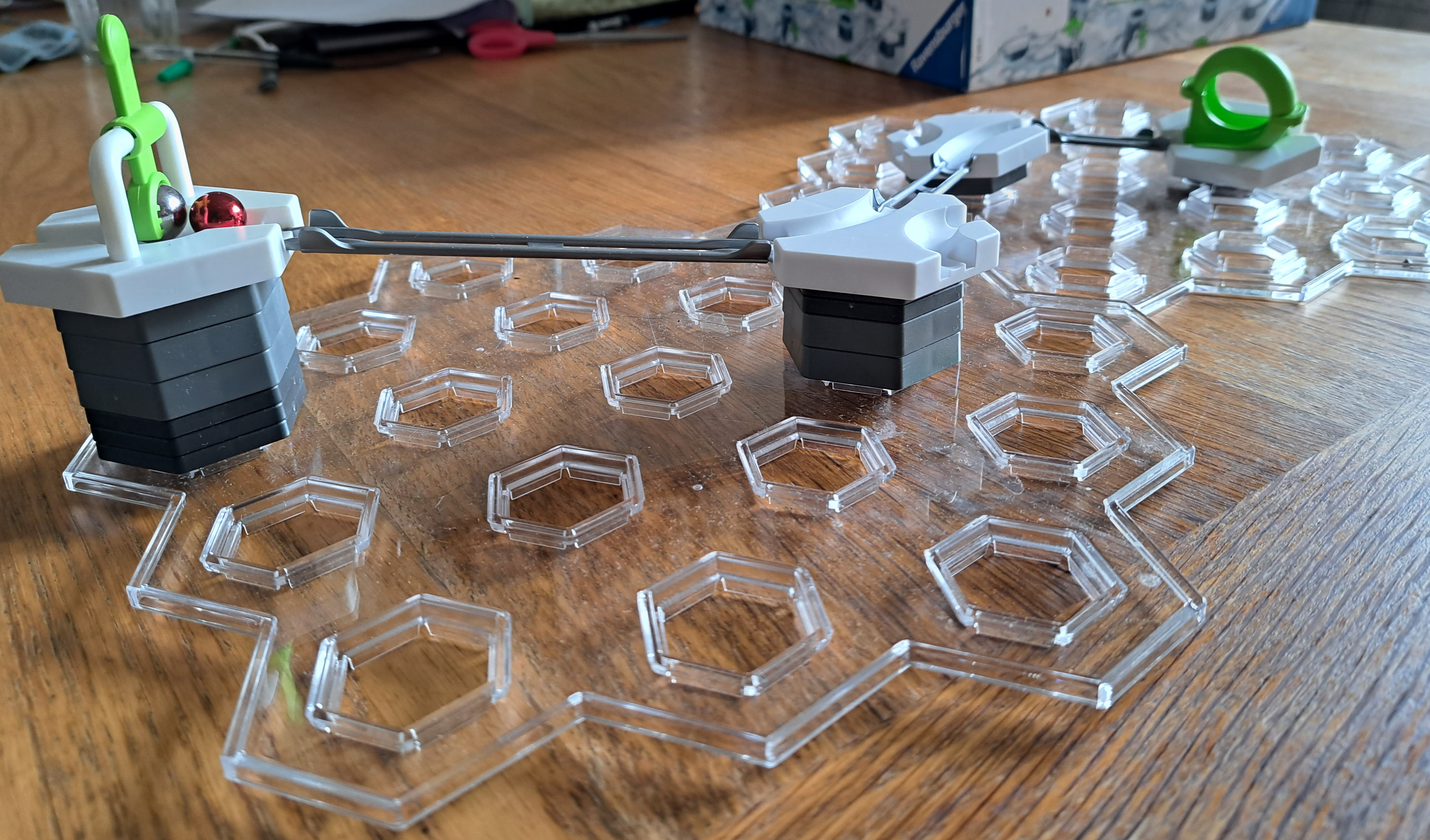
-"Lego Technic" from Lego.
Players: 1
Recommended ages: 9+ years
Time to play: 4-5 hours
Paid: Free from neighbor having a house clear-out (£20-£100's new)
Lego Technic takes regular Lego one step further. Lego Technic uses beams, axles, gears, pneumatics, etc to allow the
Lego creations to move.
Pros: A moving Lego structure is very cool. Kids learn about gears and gain intuitive understanding of mechanisms.
Kit instructions show step-by-step how to build the kit's creation. Kids can use pieces to make their own creations.
Lego Technic is compatible with normal Lego pieces.
Cons: Can be very, very expensive if buy a big kit new. May need to unbuild many steps if mechanism does not work and
need to troubleshoot. If you lose a piece, you (likely) can't build the kit.
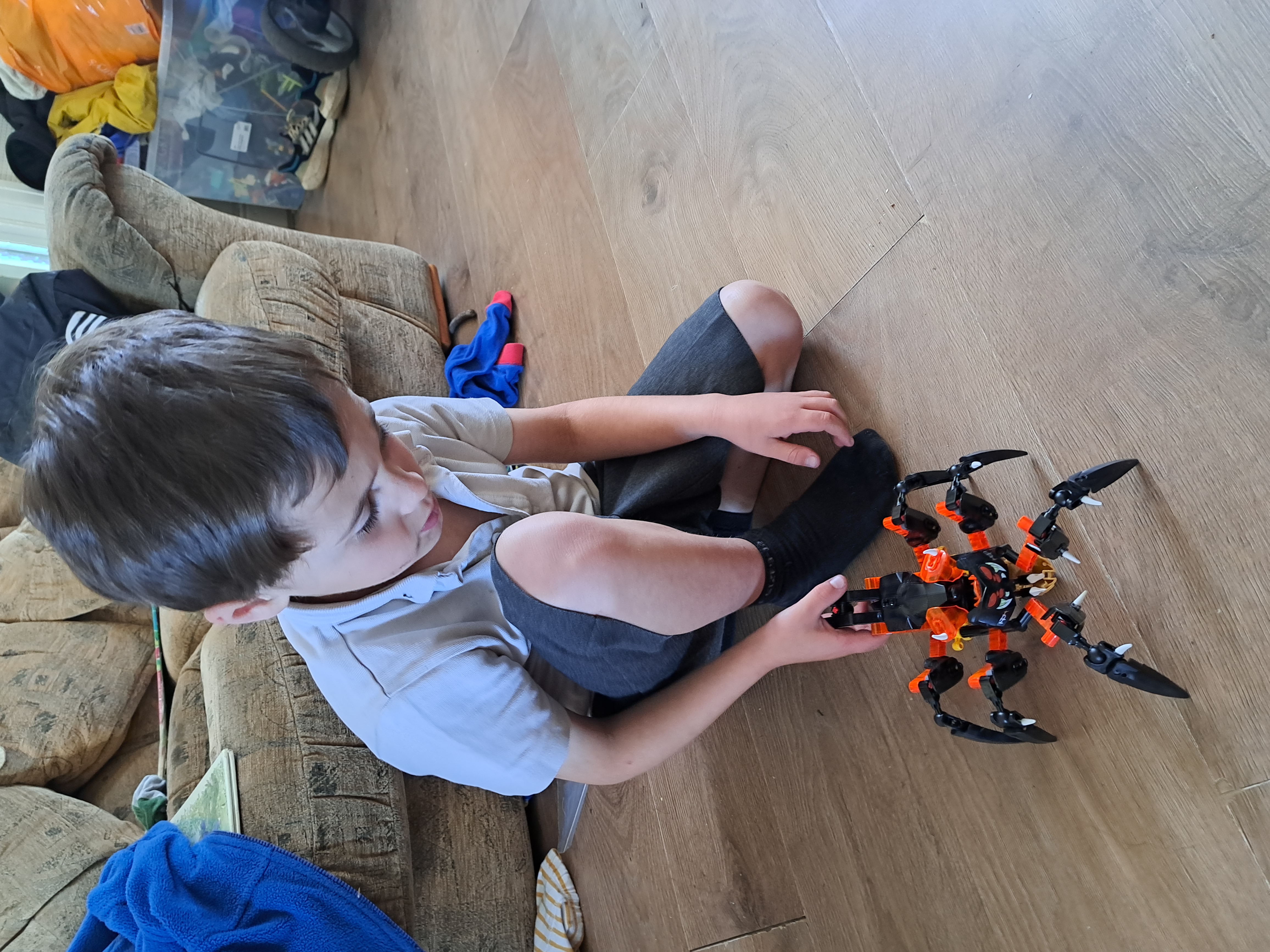
-
"Hydraulic Cyborg Hand" from Construct & Create.
Players: 1
Recommended ages: 10+ years
Time to play: 4-5 hours
Paid: £20 online
This kit has everything you need to build a Hydraulic Cyborg Hand. There is an instruction manual that clearly
shows exactly where to put the various different components. Once built, you pull on levers under the hand, and
the levers use hydraulics (water moving) to pull the fingers down. Then you can try to pick relatively light-weight
objects up with the hand, draw with the draw, etc.
I built this alongside my 5 year old. I had him identify the various part numbers in the book (practicing identifying
numbers) and then he watched as I put the hand together. We also discussed how to use a screwdriver. He loved
building a "big people project" - and playing with the hand afterwards! I think older primary school children
would be able to build this hand with adult supervision. Younger primary children will enjoy watching the process
and playing with the hand after.
Pros: Many opportunities to learn - identifying letters and numbers, using a screwdriver, how to read manuals,
how to set up hydraulics, an idea of how the human hand might work (tendons, etc). A really fun toy at the
end.
Cons: Adult supervision is needed to make sure hydraulics aren't pulled apart while playing later. I found the
hand was a bit big for my hand. A primary school student will likely not be able to hold the hand as intended.
The hand is surprisingly big once built and we've struggled to figure out where to store it!
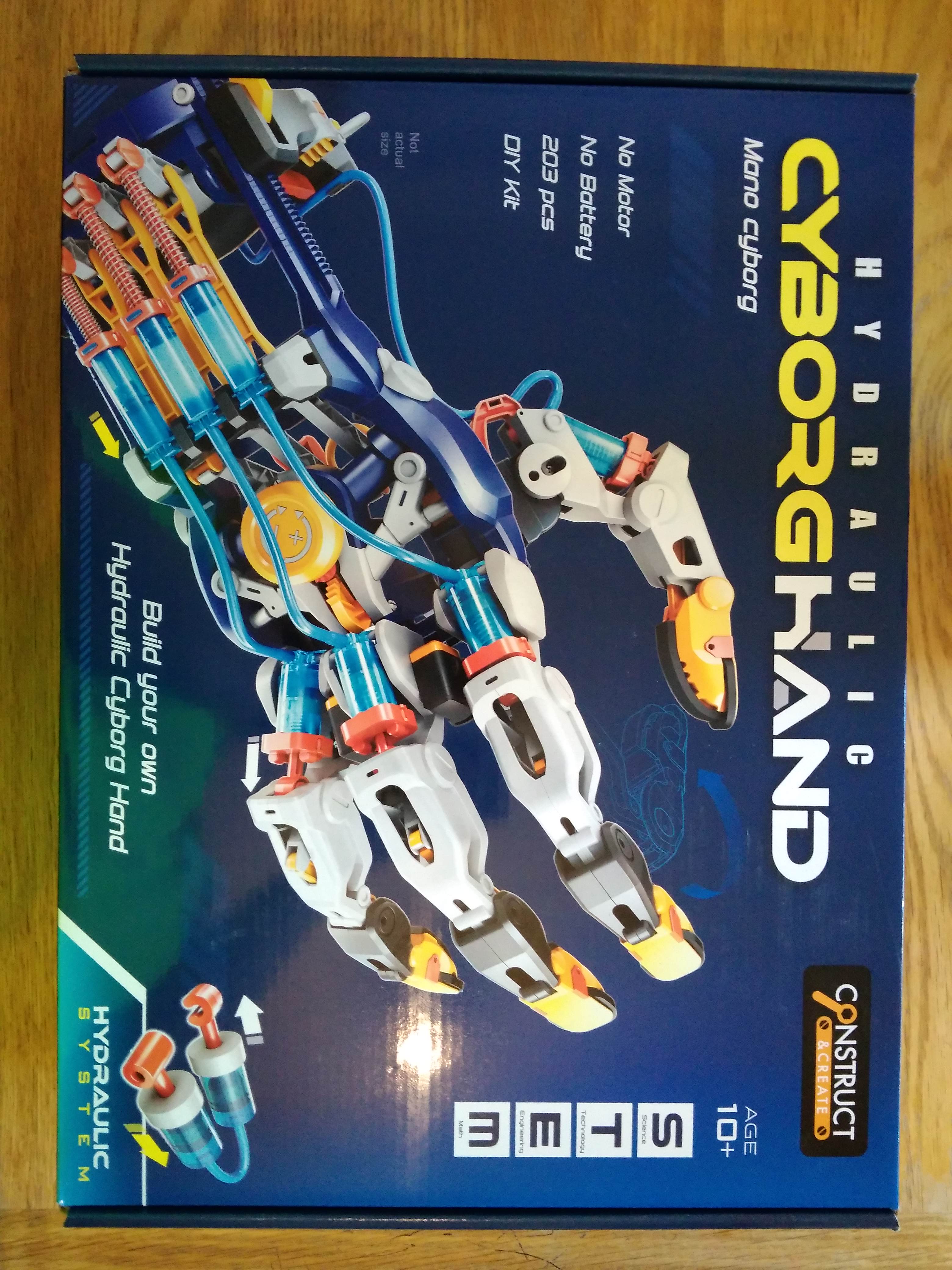
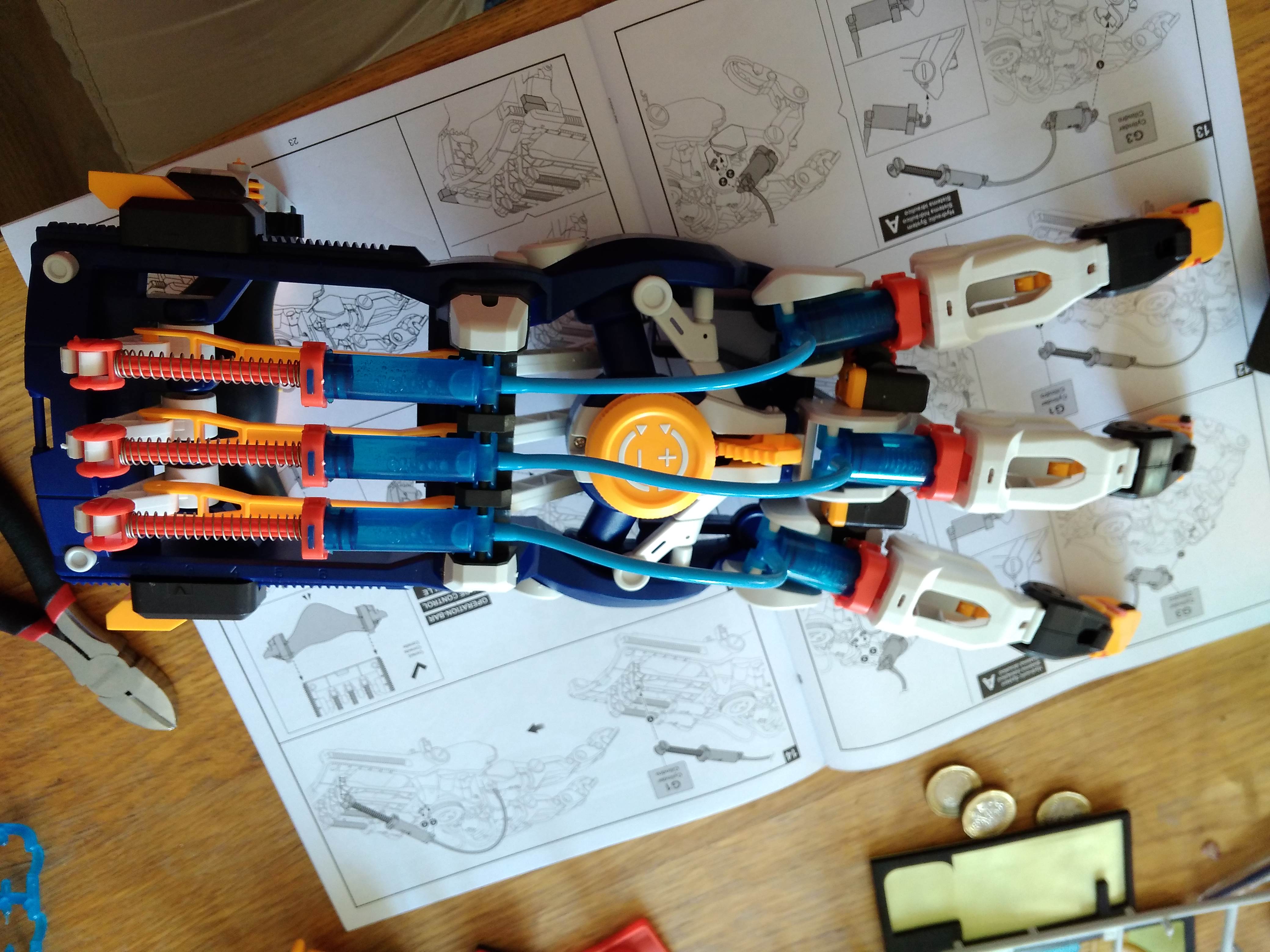
Others: "Jenga" from Hasbro, "Suspend" from Melissa & Doug, "Catapult" from The Learning Journey, "12-in-1 Solar Hydraulic
Construction Kit" from Construct & Create
E: Engineering
At this age, Engineering focuses on Problem-Solving, as well as introducing the concepts of programming
and robotics. I have selected some games and kits to teach these skills. There are many more games
that could also teach these skills. Bought new, these activities can be expensive - so I'd suggest
going to charity shops or looking for second-hand sales and buying these games or games similar to
these games.
-Problem-Solving:
"Bee Genius" from The Happy Puzzle Company.
Players: 1
Recommended ages: 3-8 years
Time to play: 15+ minutes
Paid: 50p from charity shop (reduced to free due to missing dice)
Roll 6 dice to see where to place worker bees. Then fit different shapes around the worker bees to fill the hive.
Pros: Even young kids can understand and play independently. Chunky pieces so no choking hazards (other than
replacement dice). Fun bee and hive theme. Can have multiple solutions to original worker bee placements.
Quick set-up and clean-up. Fun for children and adults (game says only for children but I enjoyed this as well).
Cons: Sometimes pieces don't fit and you have to start again - but this is relatively rare in comparison to Genius
Square. Game can't be played if any of pieces are lost.
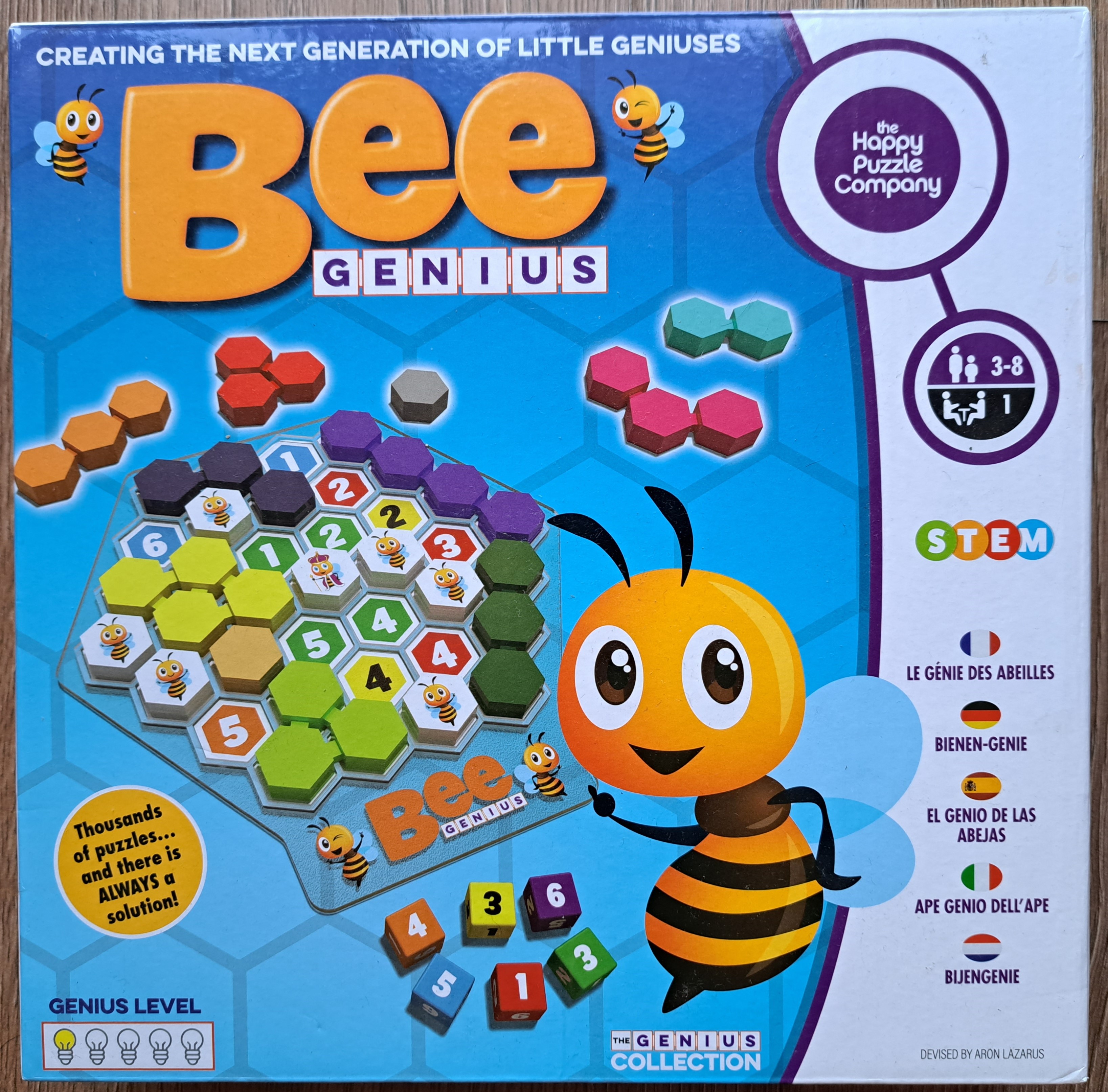
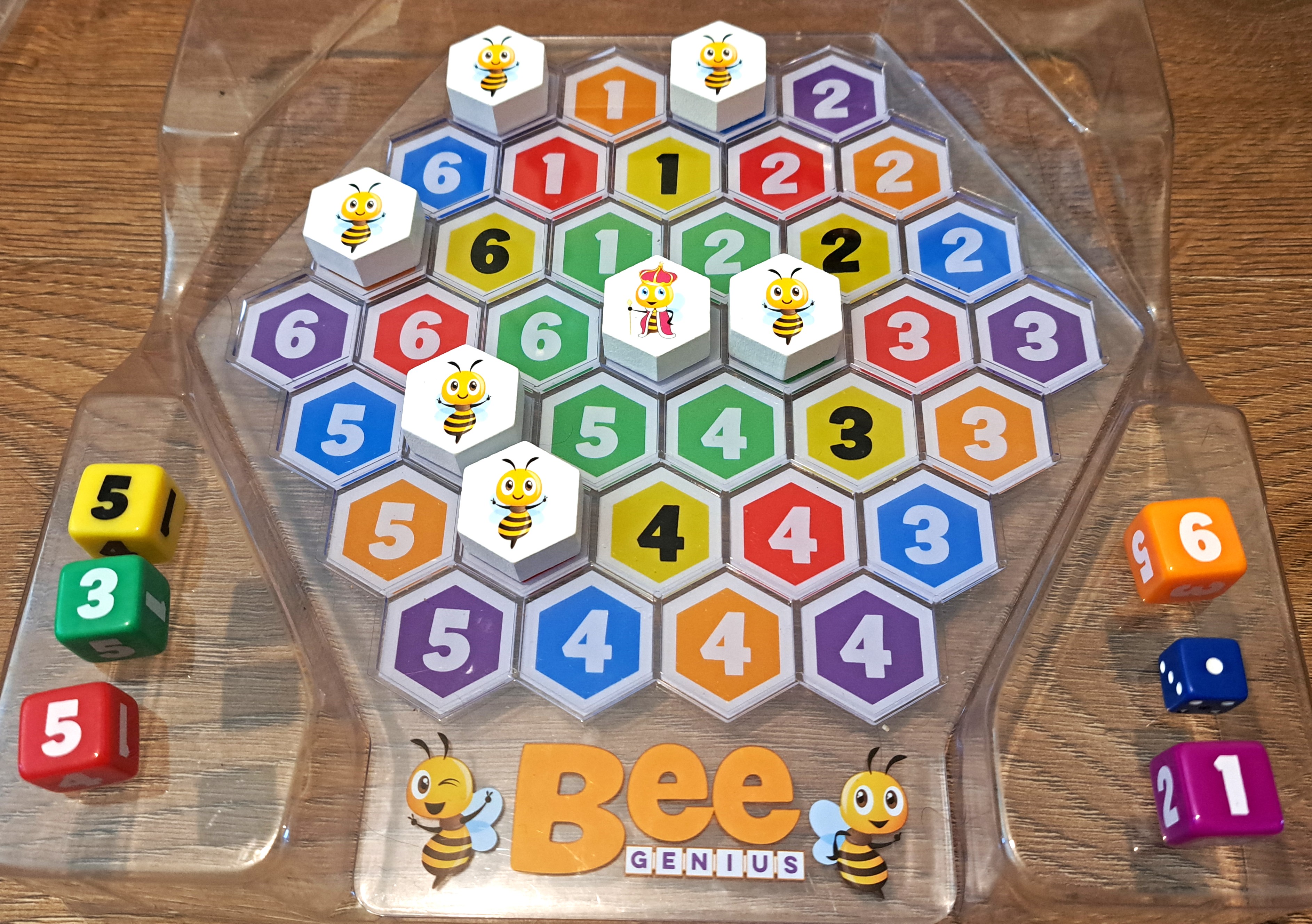
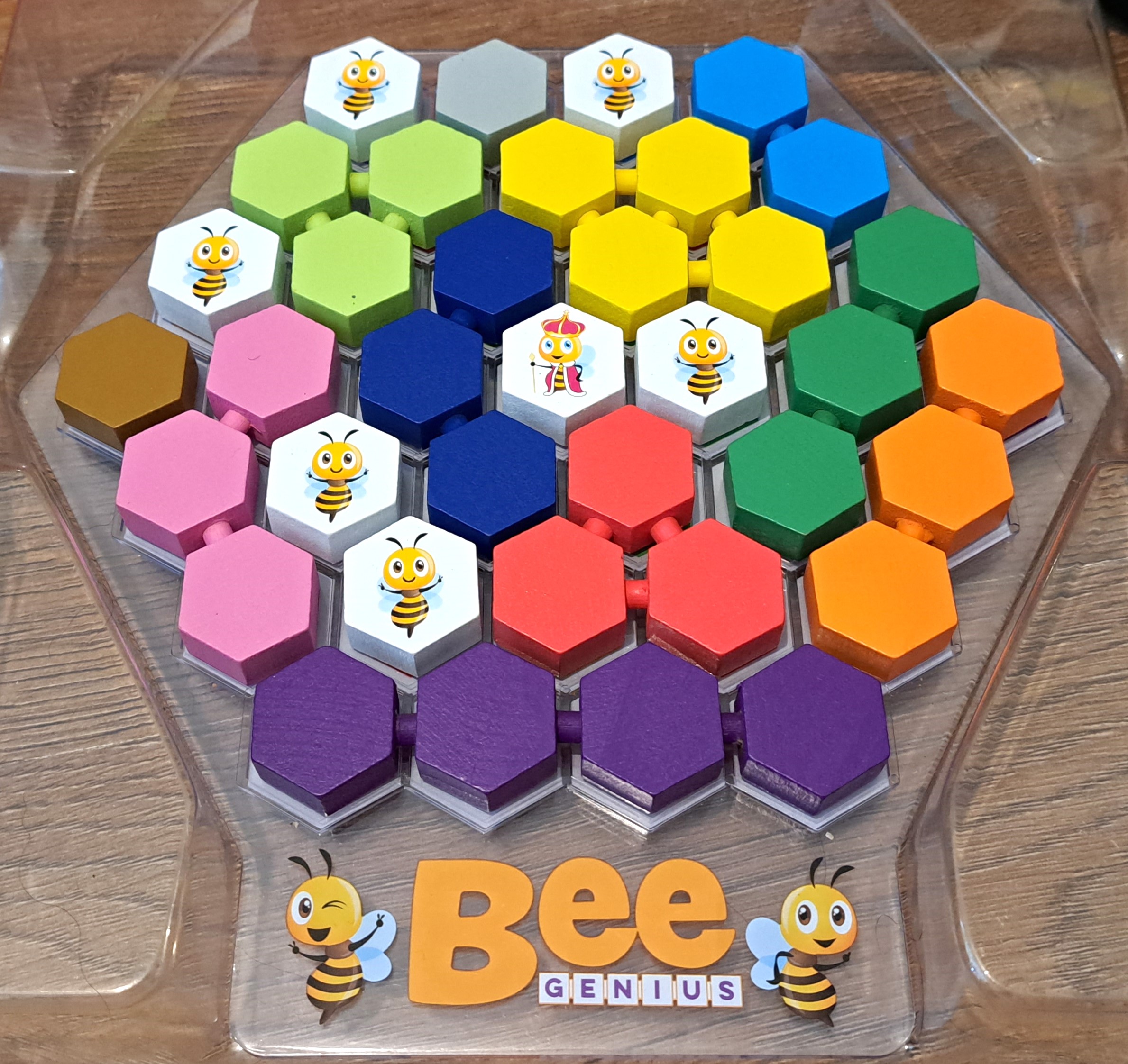
-Problem-Solving: "Roller Coaster Challenge" from ThinkFun.
Players: 1
Recommended ages: 6+ years
Time to play: 15+ minutes
Paid: £5 from second-hand online sale
40 challenge cards. Each has an initial set-up with some roller coaster parts that need to be added into the gaps.
Your job is to figure out how to use those pieces to complete the roller coaster. At the end, you can roll a coaster
(ours is lost so we use a marble) down the coaster to complete the challenge!
Pros: My 5 year old can understand and play this independently. Many different challenges so game can grow with
the child. Fun to watch coaster go down at end. Game can still be played (at least on easy levels) if 1 or 2
pieces are lost. Fun for children and adults.
Cons: Need to explain how to take pieces apart again or children may break off the attachments. No choking hazards
(other than our marble coaster).
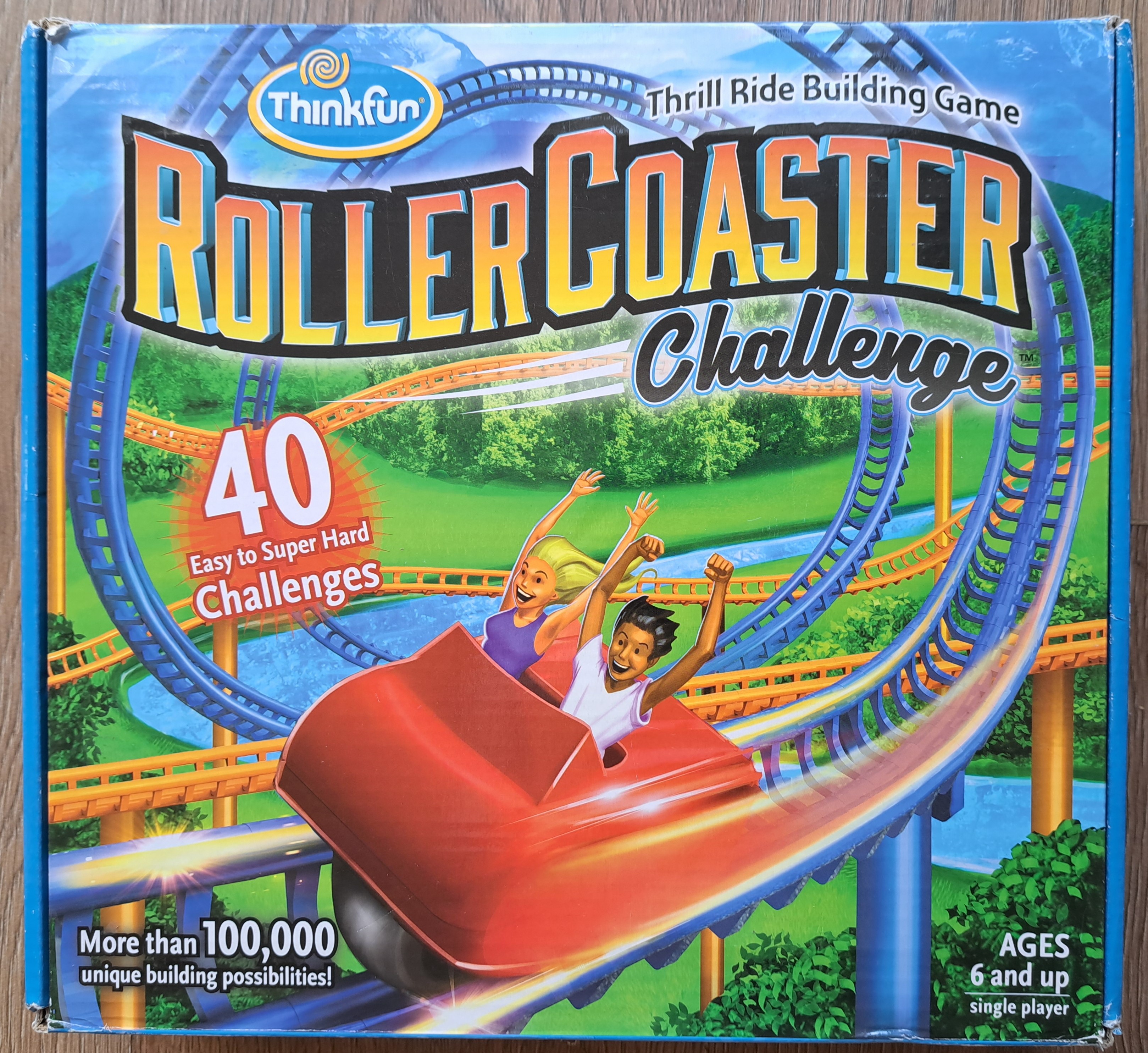
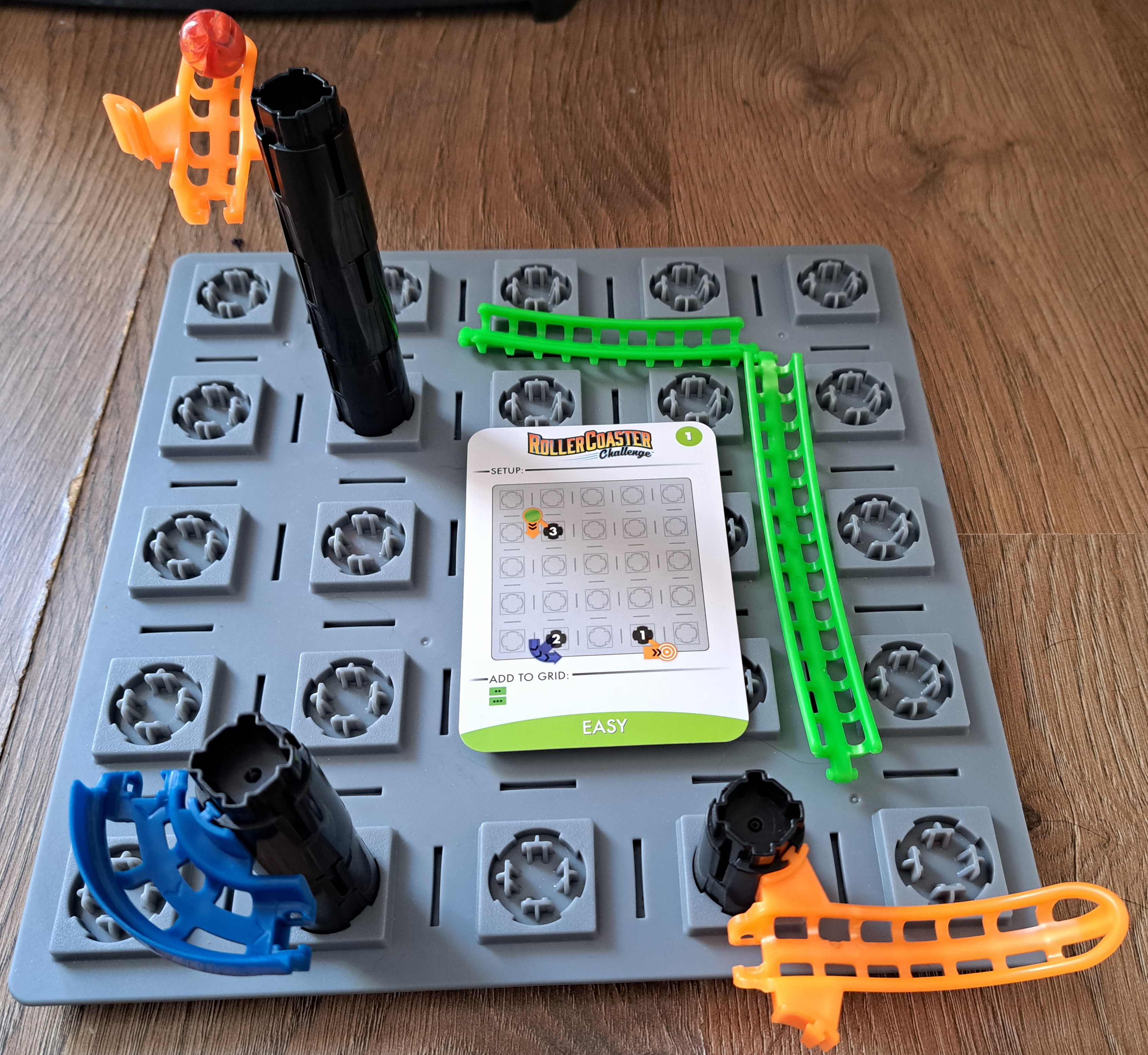
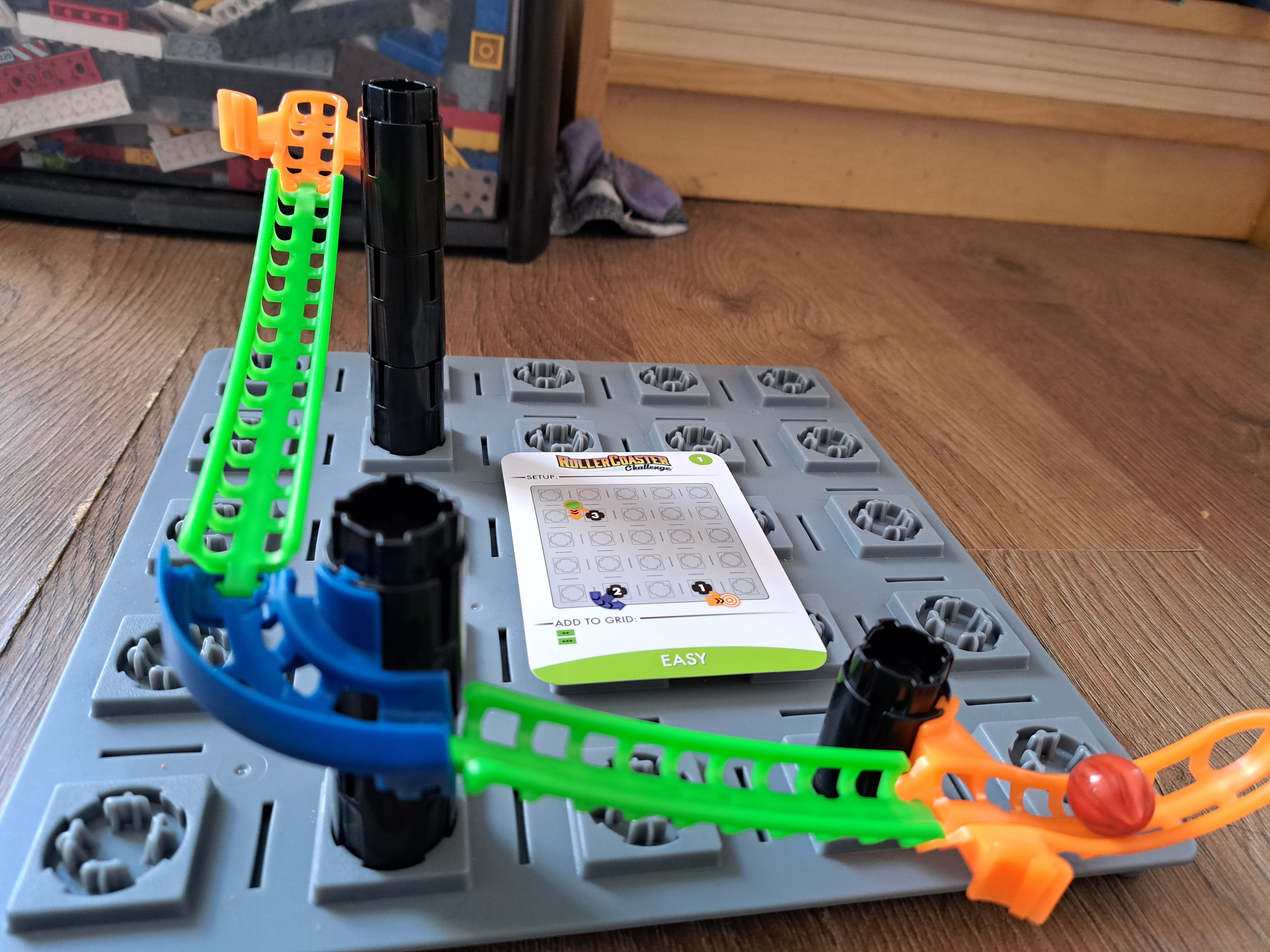
-Problem-Solving:
"Gravity Maze" from ThinkFun.
Players: 1
Recommended ages: 8+ years
Time to play: 15+ minutes
Paid: $2 from US charity shop
60 challenge cards. Each card has an initial set-up with some tower pieces placed in specific locations. The card
also shows which additional tower pieces are needed (but not their locations or orientations). Your job is to
figure out where to place each tower to allow the marble to go from the top of the highest tower down to the single
red tower to complete the challenge!
Pros: My 5-year old could understand and play this independently (on the easy level). He liked playing a "big person
game". Chunky pieces are easy to handle (exception of marbles). Fun for children and adults. Quick set-up and clean-up.
Cons: Marbles are choking hazards. Game can't be played if any tower pieces are lost.
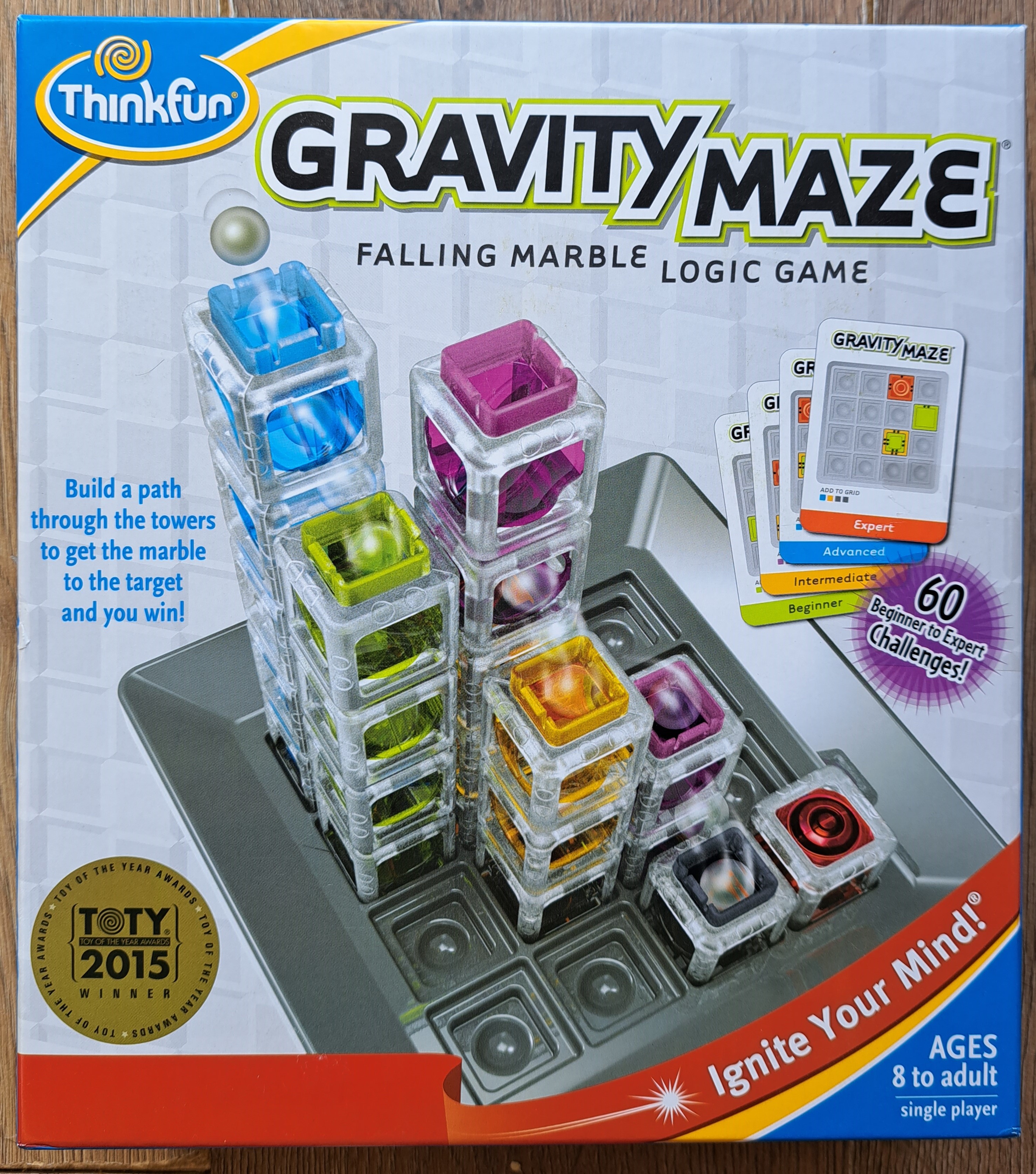
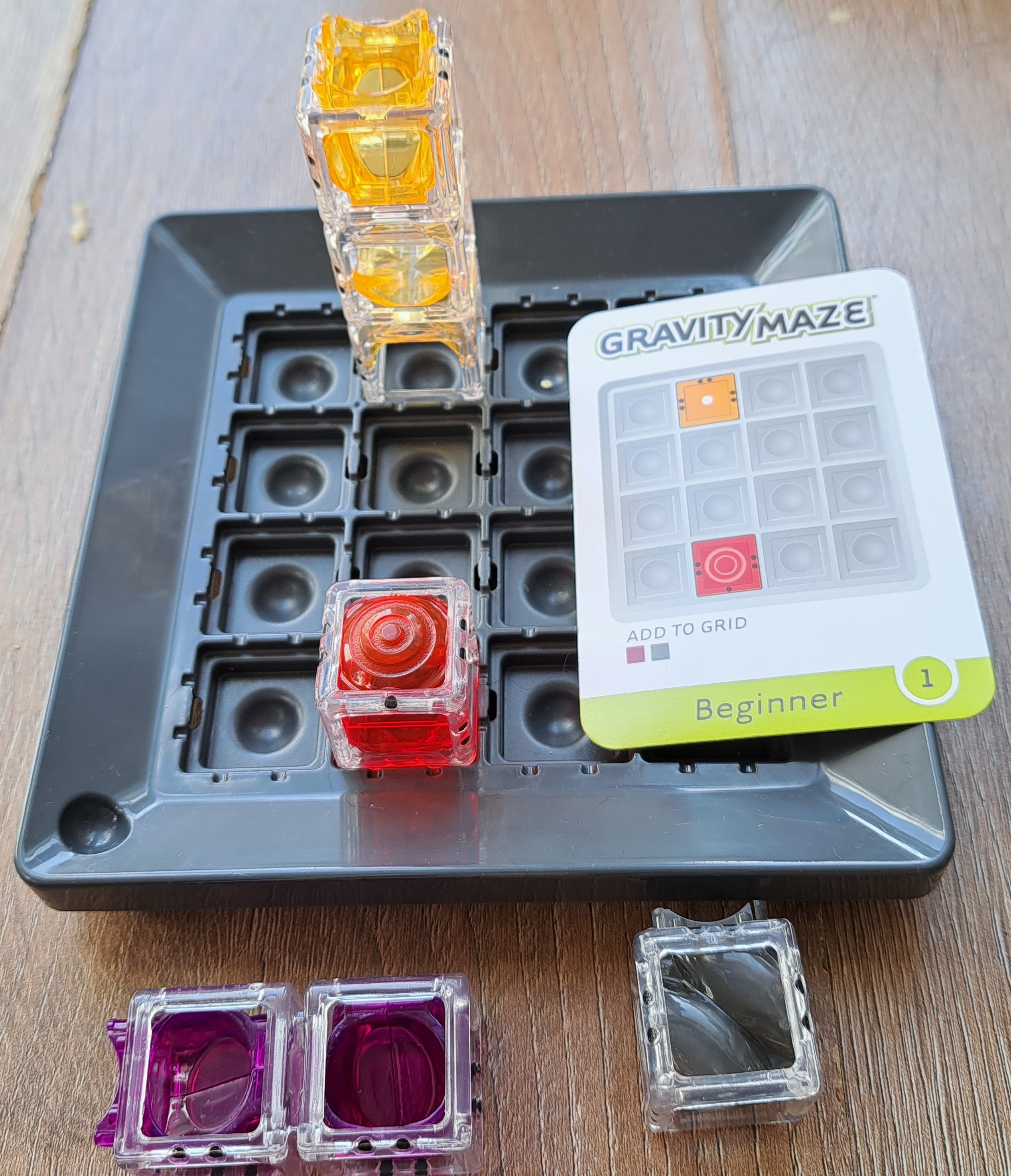
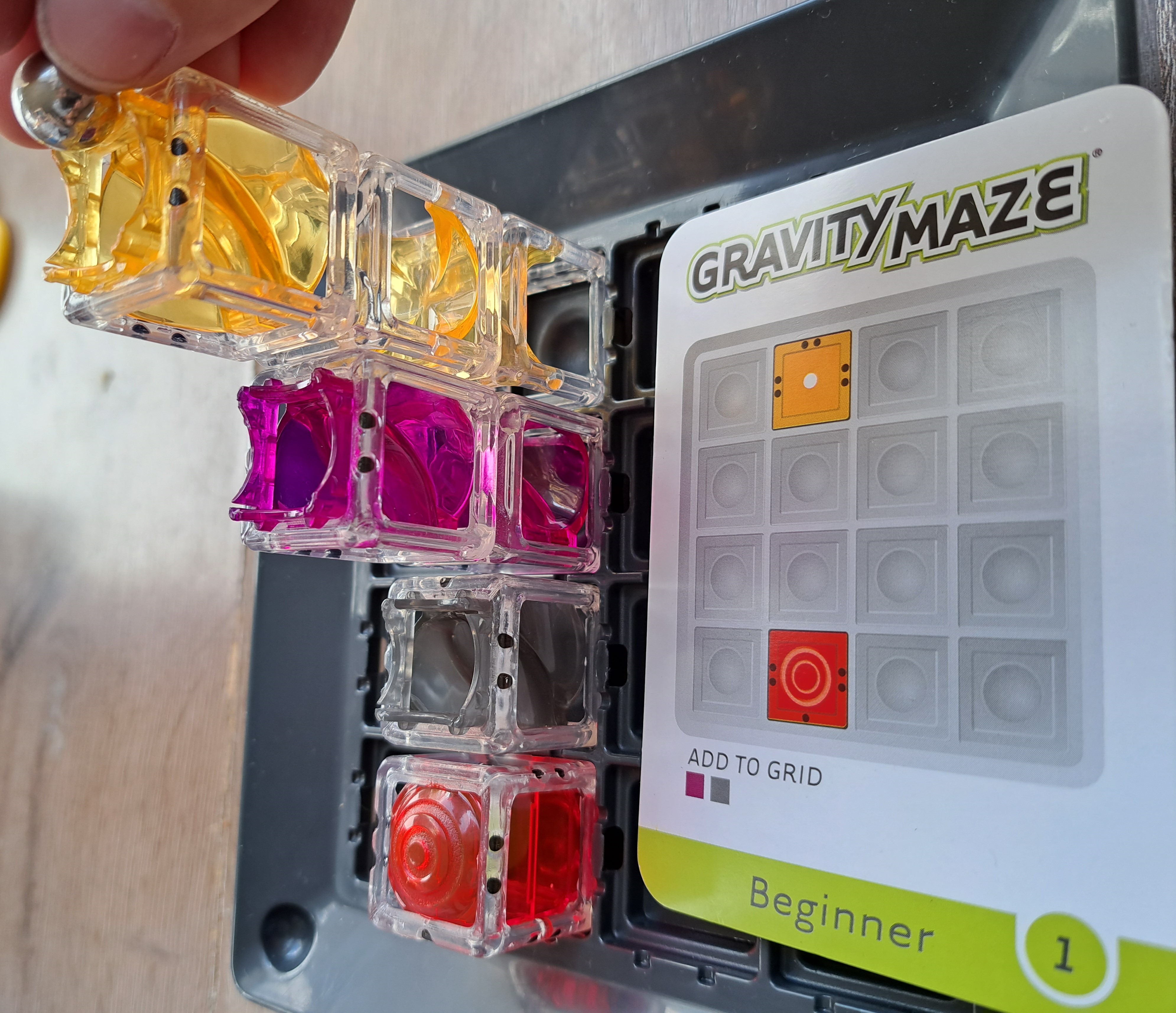
-Problem-Solving: "Villageo" from Blue Orange.
Players: 1
Recommended ages: 8+ years
Time to play: 15+ minutes
Paid: £9 from Steam Rocket
60 challenge cards. Each challenge card has a 6x8 grid, with some spaces of the grid colored in and other spaces
blank. You have to place 16 L-shaped, colored pieces over the colored grids. The catch is that two pieces of the
same color can not touch each other (even diagonally).
Pros: Excellent travel-sized game. Range of difficulty levels. Doesn't take up a lot of space to play. Good
replayability. Quick set-up and clean-up.
Cons: Game can't be played if any pieces get lost. Game board can't actually fit inside the box while being played
- so we 3D printed our own card holder.
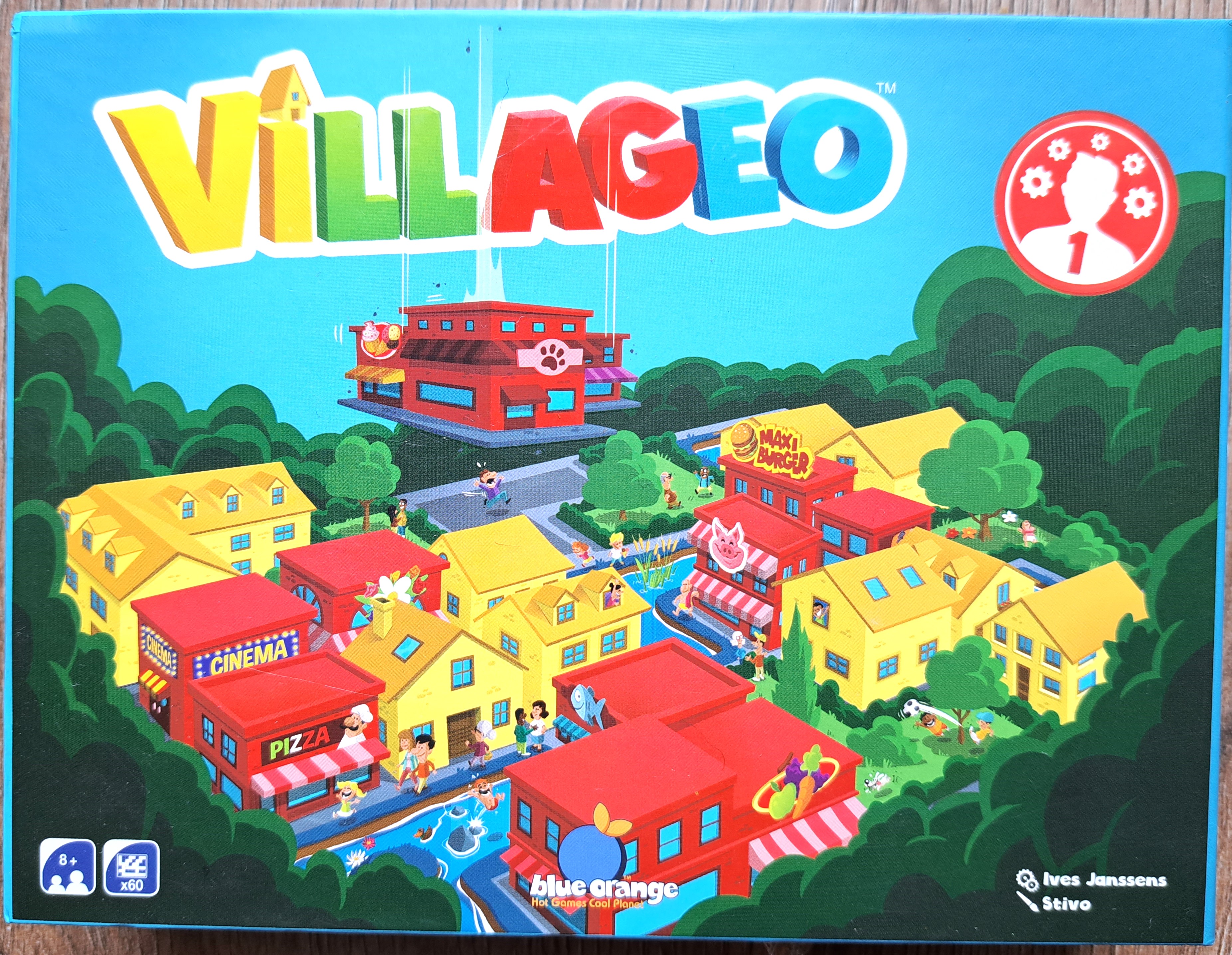
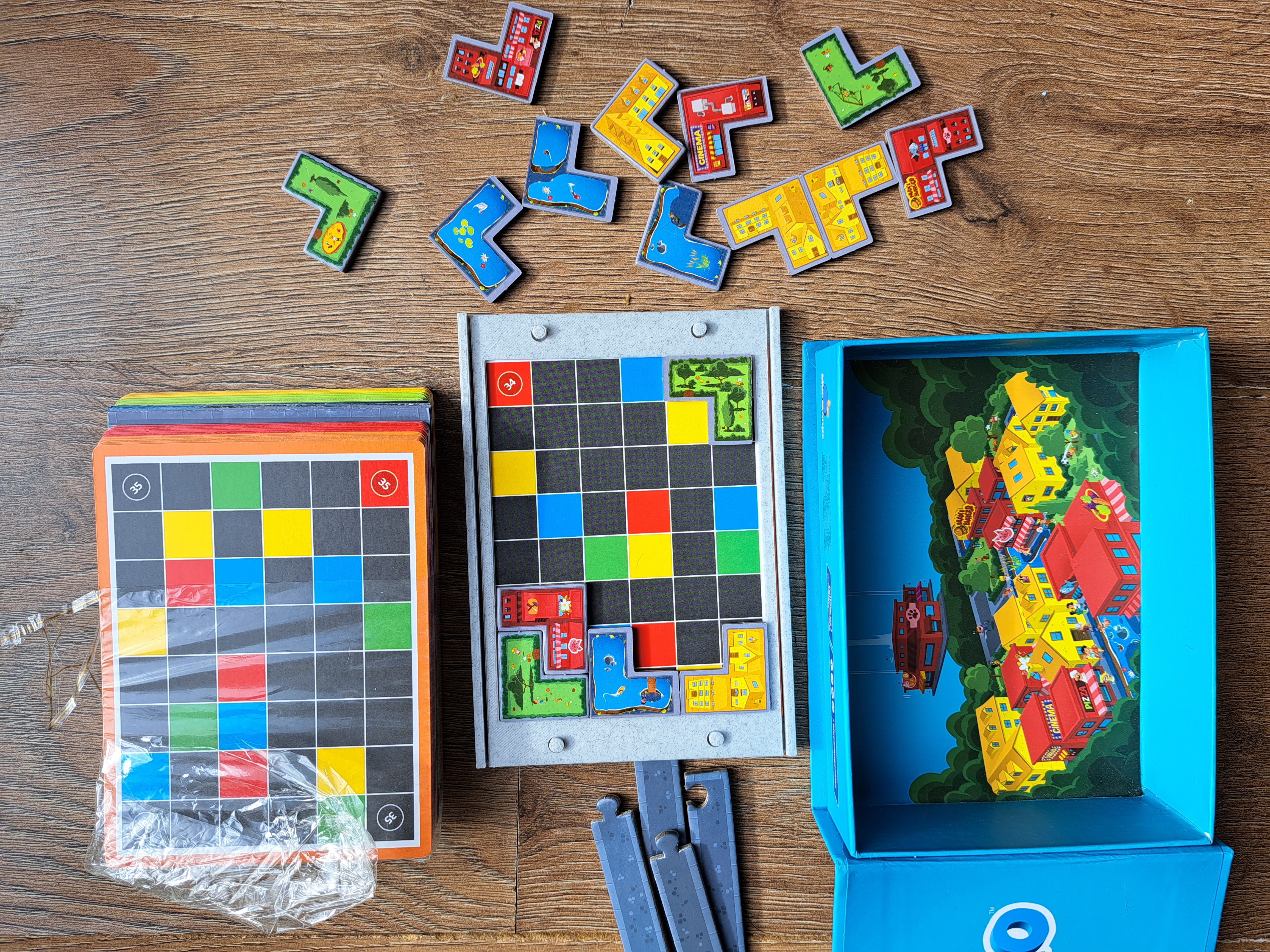
Other Problem-Solving Games: "Circuit Maze", "Laser Maze", "Rush Hour", "Dog Crimes", "Cat Crimes" (all from
ThinkFun); "Engineering Ants" from Peaceable Kingdom
-Programming: "Robot Turtle" from ThinkFun.
Players: 2-5
Recommended ages: 4+ years
Time to play: 20+ minutes
Paid: Free from online sale because missing pieces and damaged
Competitive game where each person controls a turtle and uses turn left, turn right, and go forward cards to try to reach
their jewel first. The simplest set-up is shown. There are also extra obstacles that can be placed on the board as
children's understanding of programming cards improves. The instructions say the parent should act out the turtles'
motions and make weird noises to make the game more entertaining for kids.
Pros: Teaches kids the very basics of programming (that cards lead to actions).
Cons: Our game was missing most of the turtles and jewels - we made replacement 3D printed versions but it's just
not the same. I don't like having the kids competiting; I prefer cooperative games. Really needs at least 2 kids
for the game to work so not great for only children.
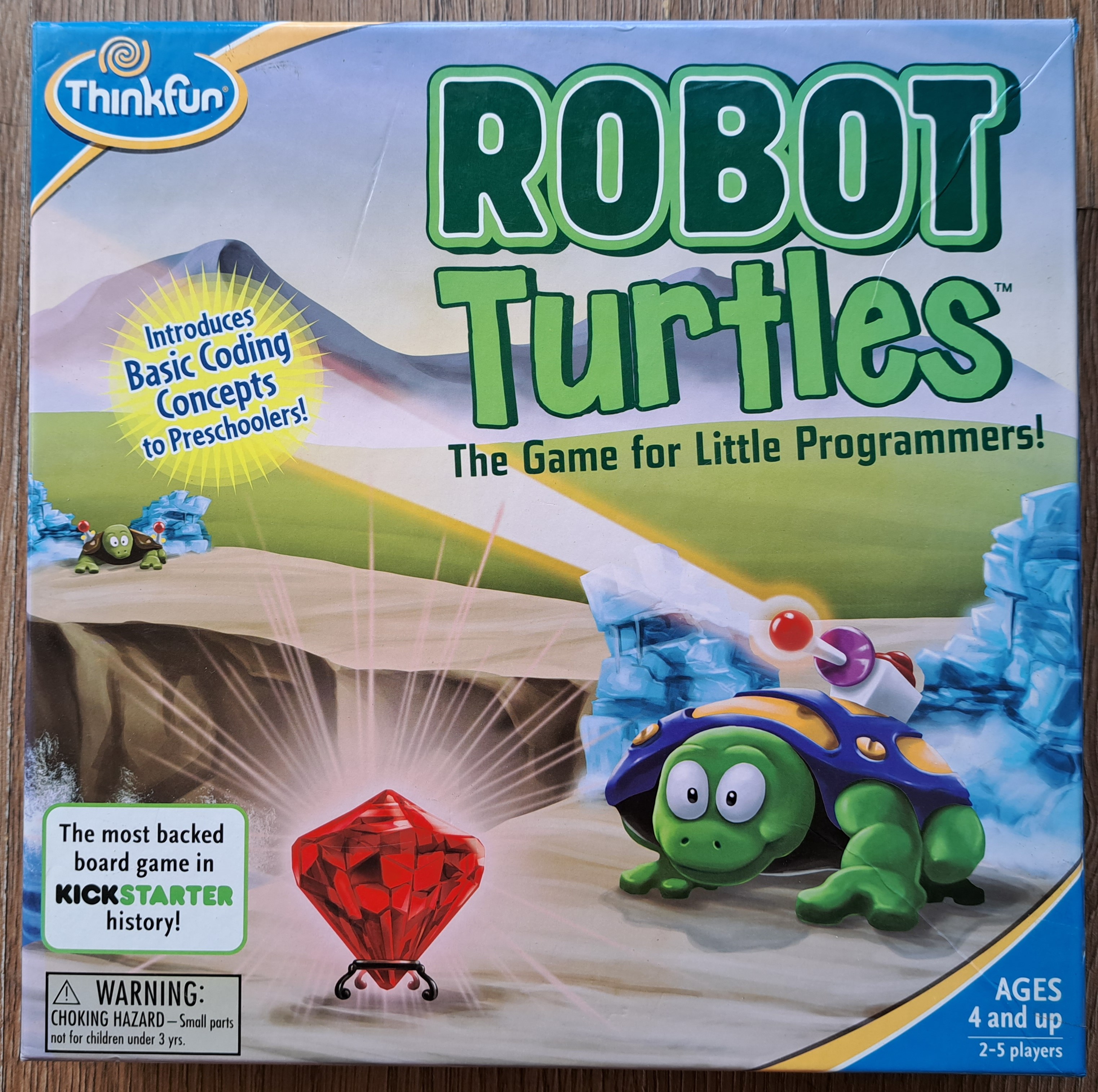
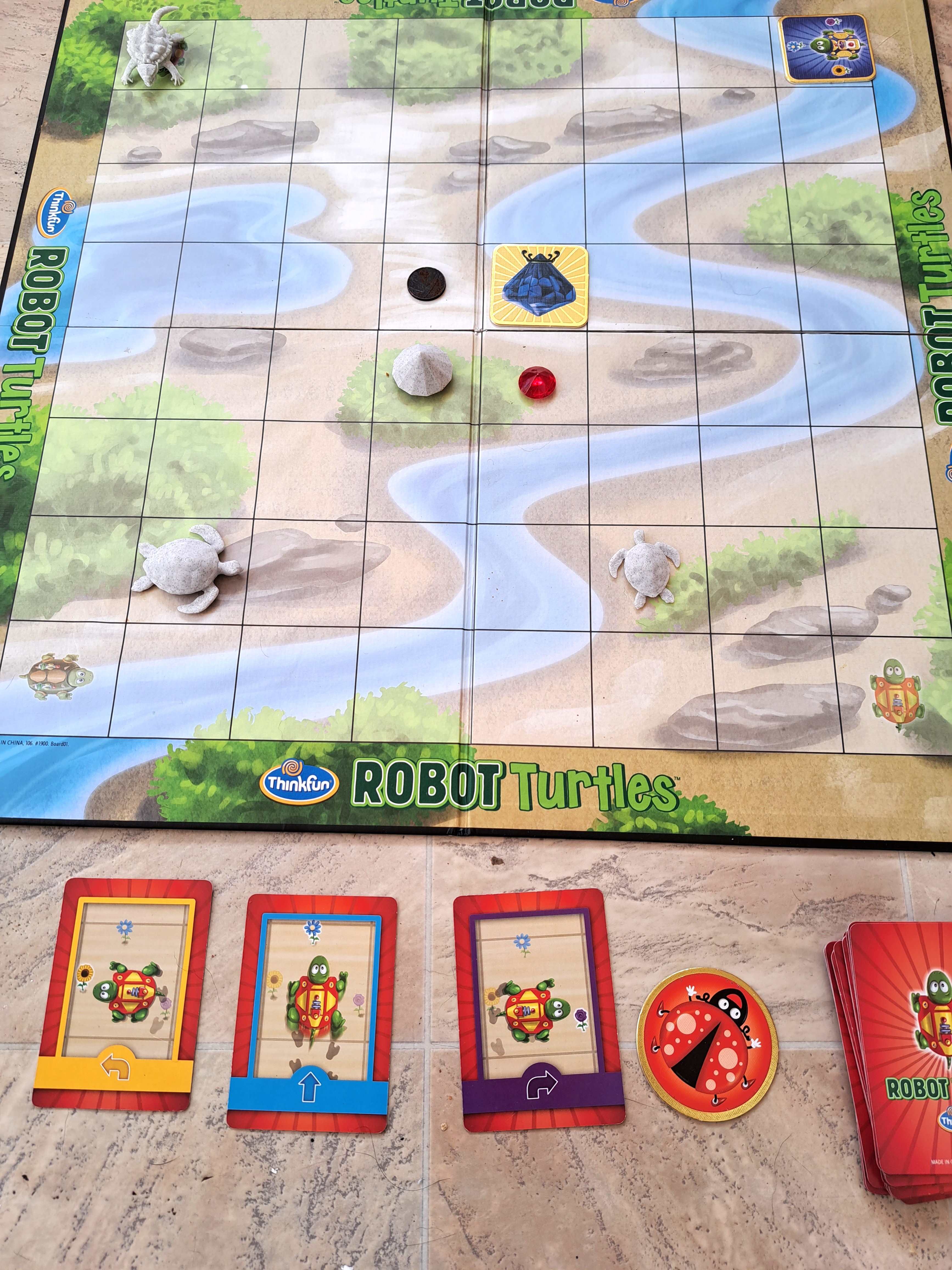
-Programming: "CodeMaster" from ThinkFun.
Players: 1
Recommended ages: 8+ years
Time to play: 20+ minutes
Paid: £7 from online second-hand sale
60 Challenges. Each challenge has a map that indicates the locations where the hero (red figure) starts and the end
portal (gray figure) is located, as well as any blue crystals to collect or trolls to avoid. The script also indicates
how many coins of each color need to be used. The coins represent the paths the hero has to take to go from the start
to the end positions.
Pros: Engaging Minecraft theme. Difficulty levels increase as programming logic ability improves. I love the look
of the map and scrolls! Fun for children and adults.
Cons: Game can't be played if any pieces are lost (although could substitute other coins or figures easily). Minecraft
is sterotypically boy'ish, which may mean some girls aren't interested in the game.
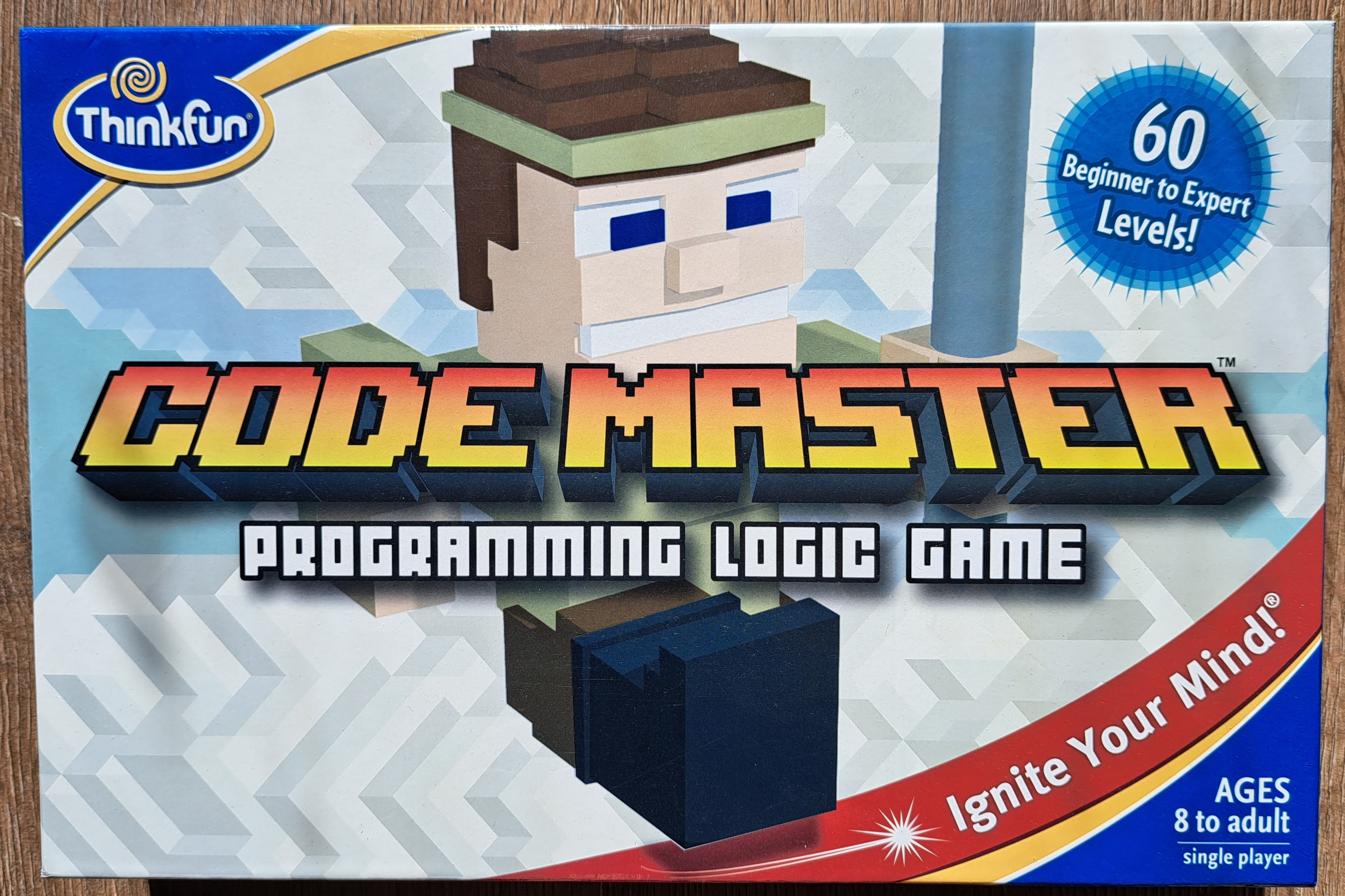
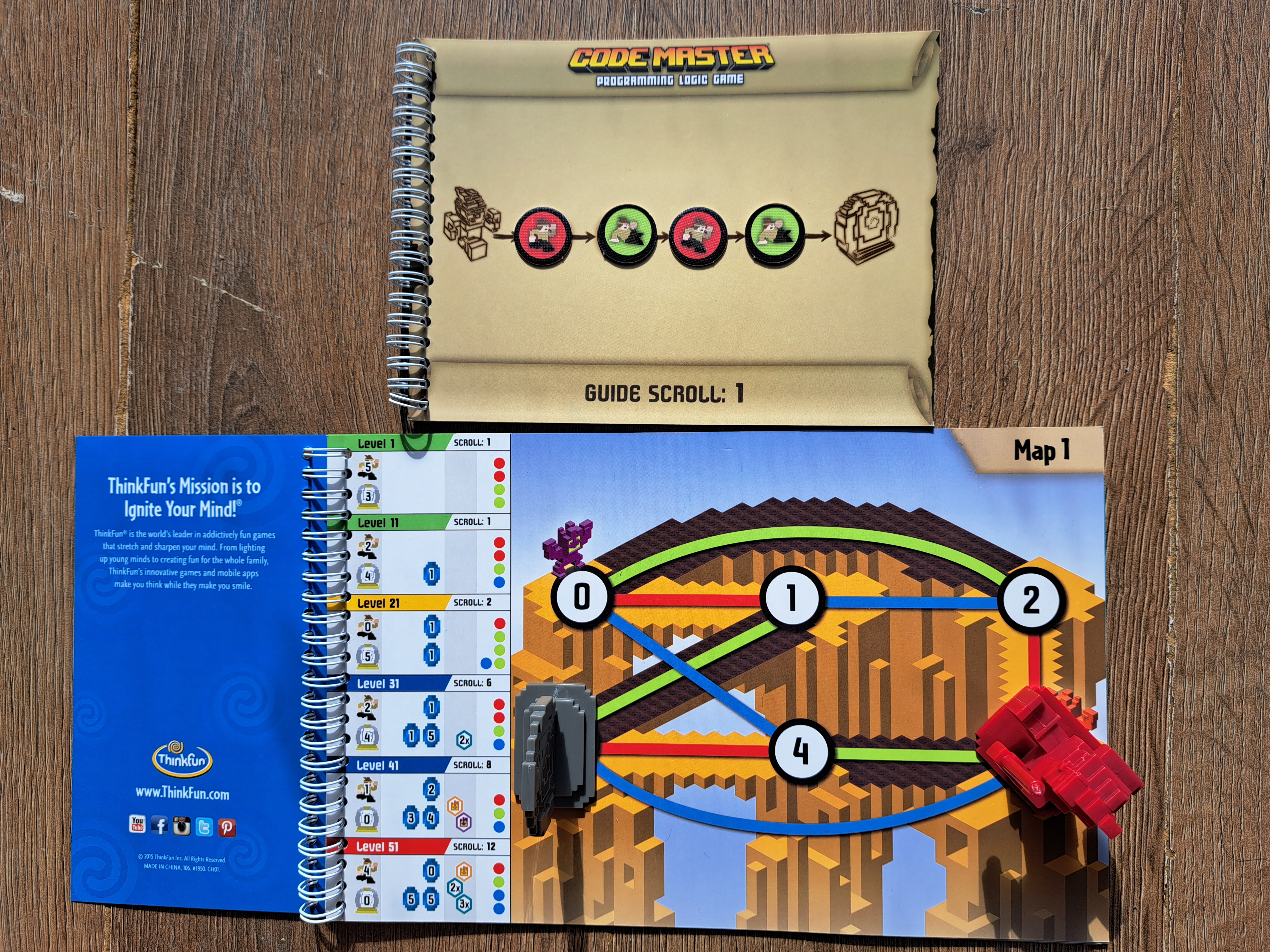
-Programming:
"Quirky Circuits" from Plaid Hat Games.
Players: 2-4
Recommended ages: 8+ years
Time to play: 20+ minutes
Paid: £15 from Magic Madhouse
Limited-communication cooperative game with 20 scenarios. Players use turn right, turn left, go forward cards to move
a robo cat-vacuum
around the room to collect dust bunnies - or a skiing penguin to collect flags - before the robot's batteries run out.
The players can't say which cards they are going to play, however, so the robot doesn't necessarily go where you expect!
When we play with our 5 year old, we allow more communication than game recommends to make the game easier to play.
Pros: Fun theme which isn't stereotypical girl or boy. Cooperative which I love! Limited communication adds another
dimension to game. Cute figures and artwork.
Cons: Can cause disagreements if robot doesn't go where you expect.
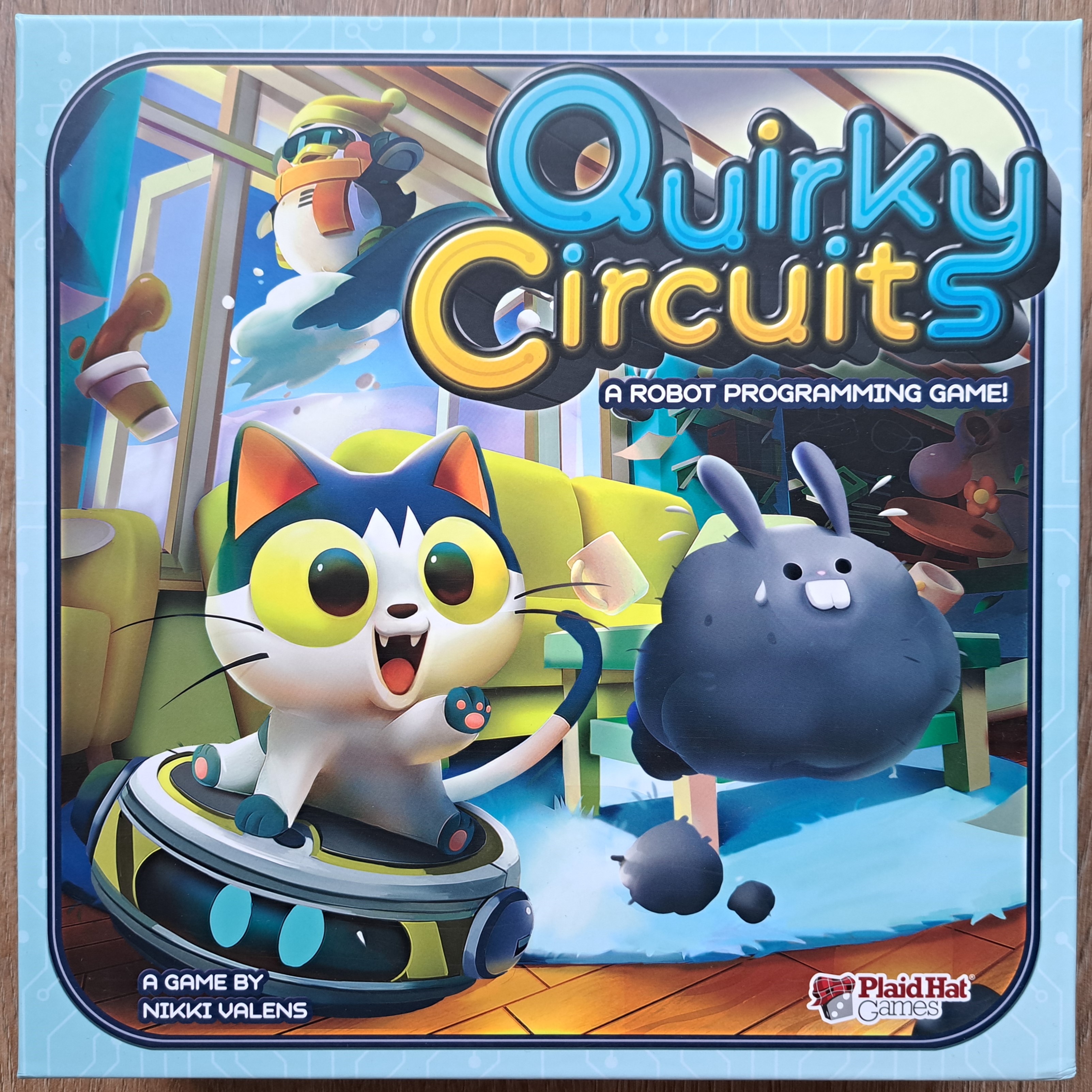
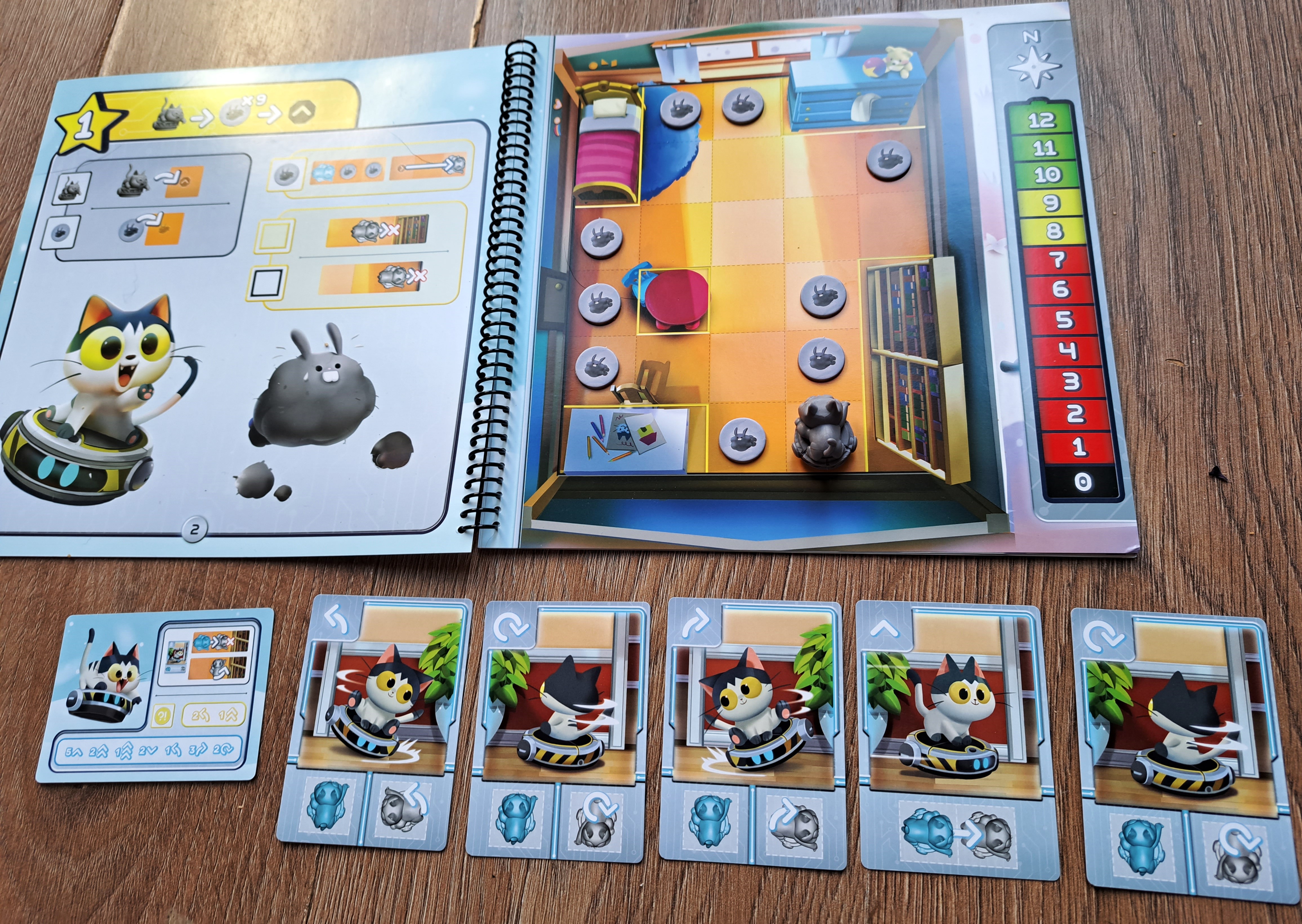
-Programming: "Scratch" from the Lifelong Kindergarten Group at the MIT Media Lab.
Players: 1+
Recommended ages: 8+ years
Time to play: 10+ minutes
Paid: Free online
Free online drag-and-drop coding. Prompts, images, sounds, etc are provided to add into your program (or you can use
your own!). The character (called a "sprite") then does whatever the program says. For the 2 programs below, I had
the kids tell me what to have the sprites do, and then I found the drag and drop blocks to create it. The kids loved
seeing their creations come alive! (The dog chases the cat - and the dinosaur looks for the bear.)
Pros: Intuitive. Free. Fun. A great first experience with computer coding, where syntax doesn't hold you down. Can
quickly make changes to code and see changes' effects.
Cons: None.
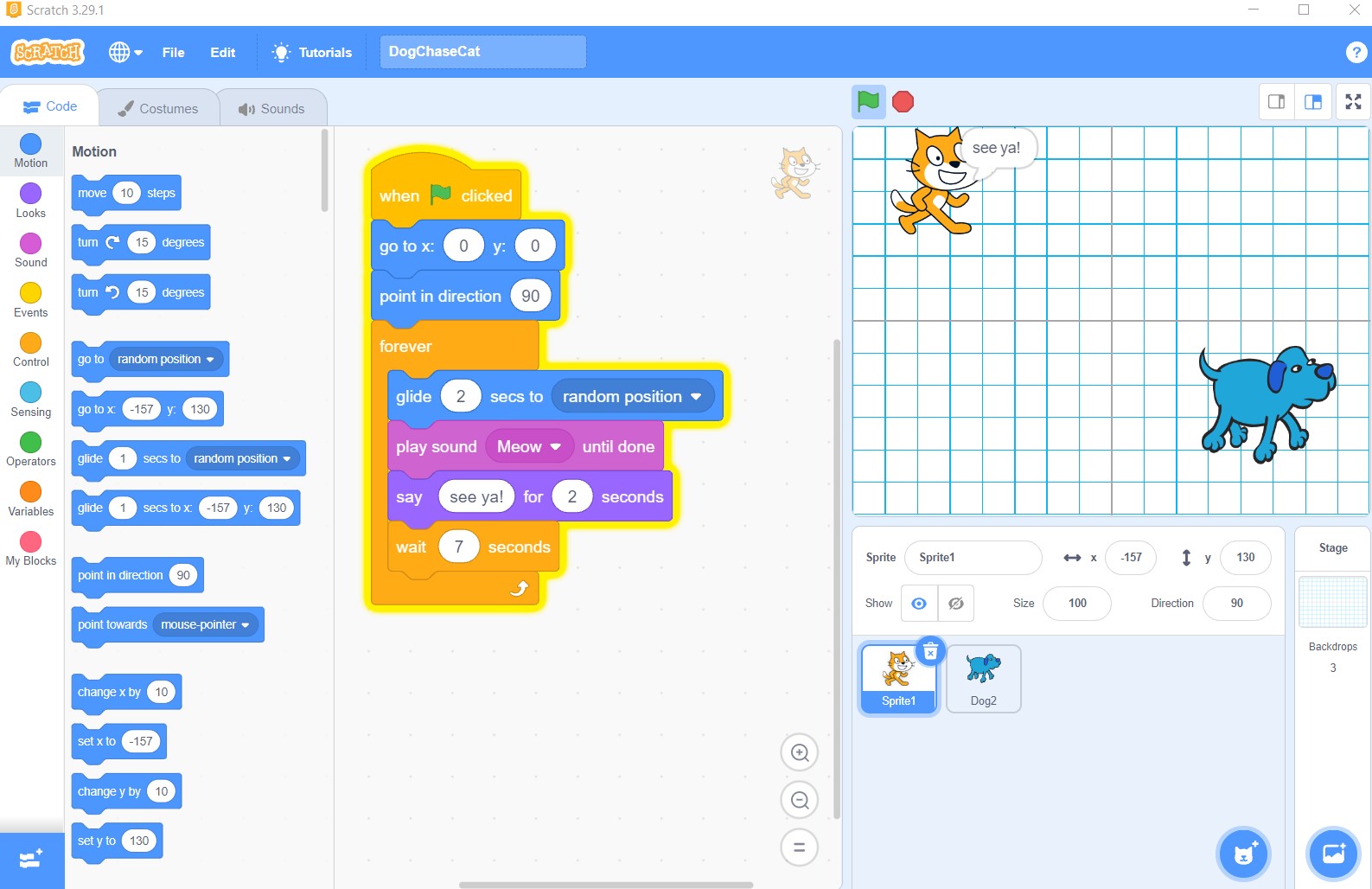
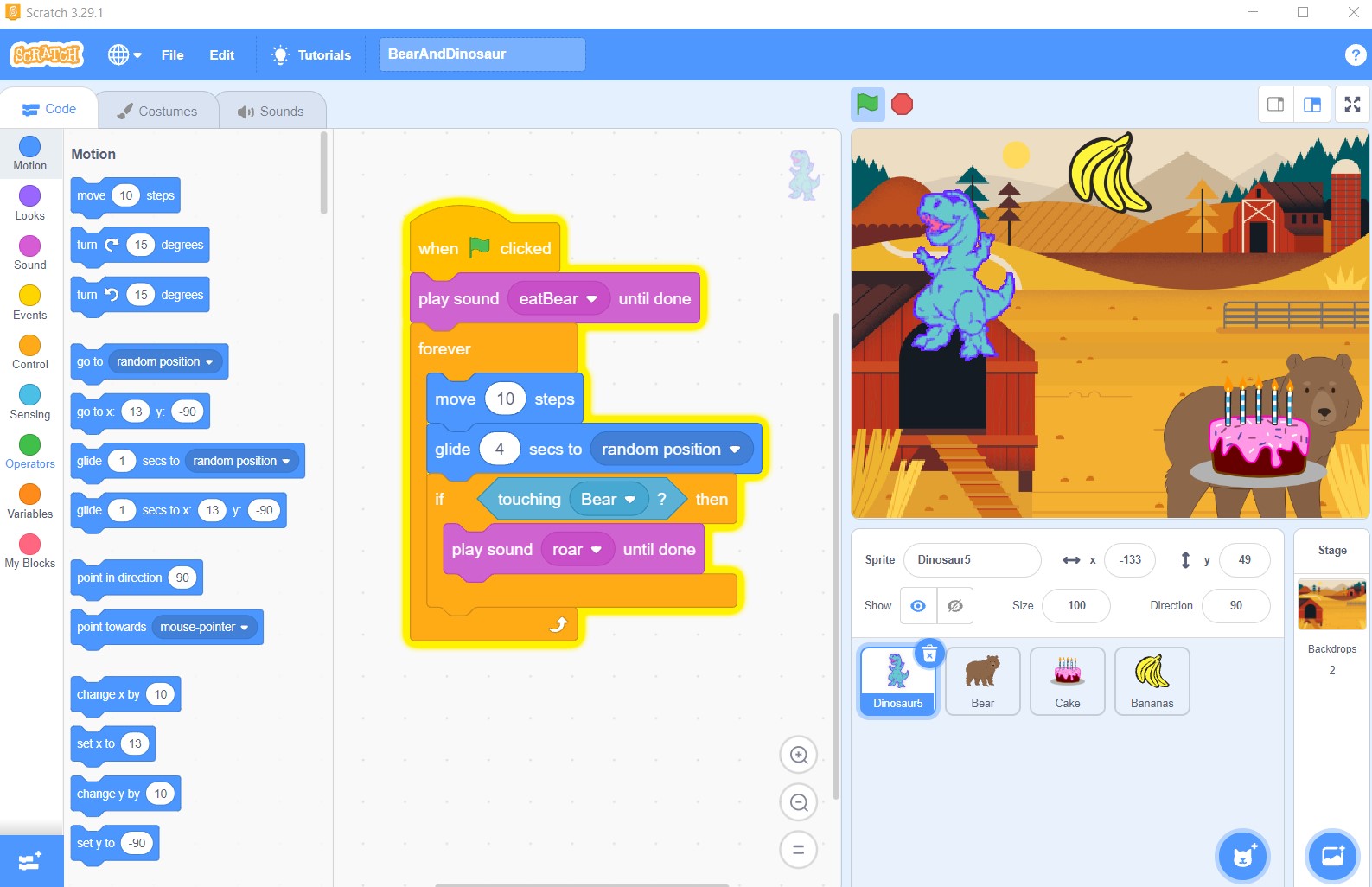
Other Programming Games: Mouse Mania, Bad Maps
-Robotics: "Power Tracks" from John Adams.
Players: 1+
Recommended ages: 5+ years
Time to play: 20+ minutes
Paid: £19 from Amazon (I bought online second-hand for £5 but was refunded because Volty did not work)
Build a circuit for Volty to follow. Certain cards have special features: Volty sings or his eyes light up, etc.
I was so excited about this game. Unfortunately, our Volty would not track the line, however, so we can't
actually play the game... I was so disappointed.
Pros: Looks like a very exciting, interactive game to teach programming! Variety of difficulty levels. Volty
is so cute!
Cons: We could not get Volty to track the line - so could not play the game - which was very frustrating.
The person we bought this from did not know it was broken, which might be why her children did not enjoy
playing it. I hope this experience hasn't turned her kids off STEM!
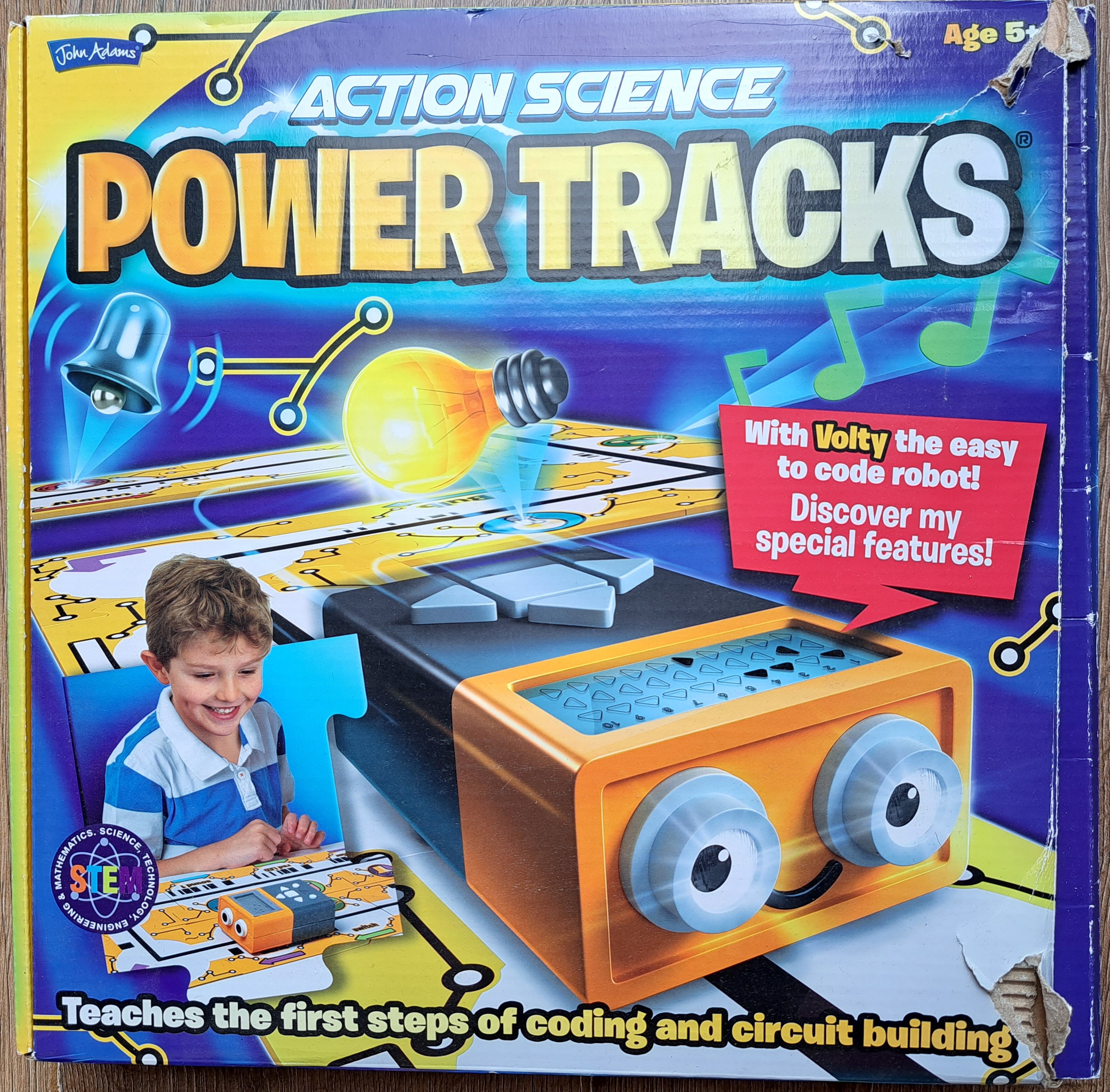
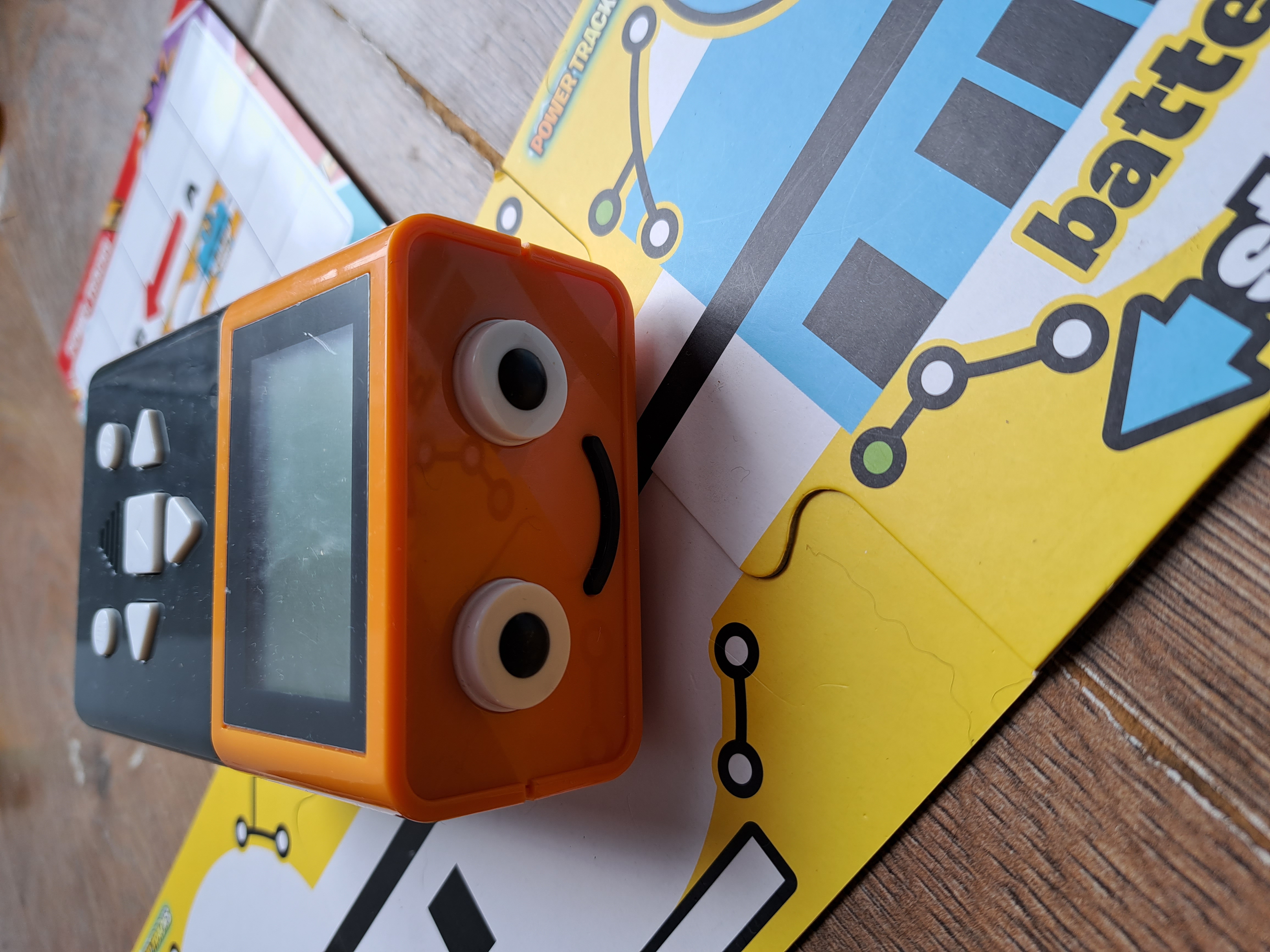
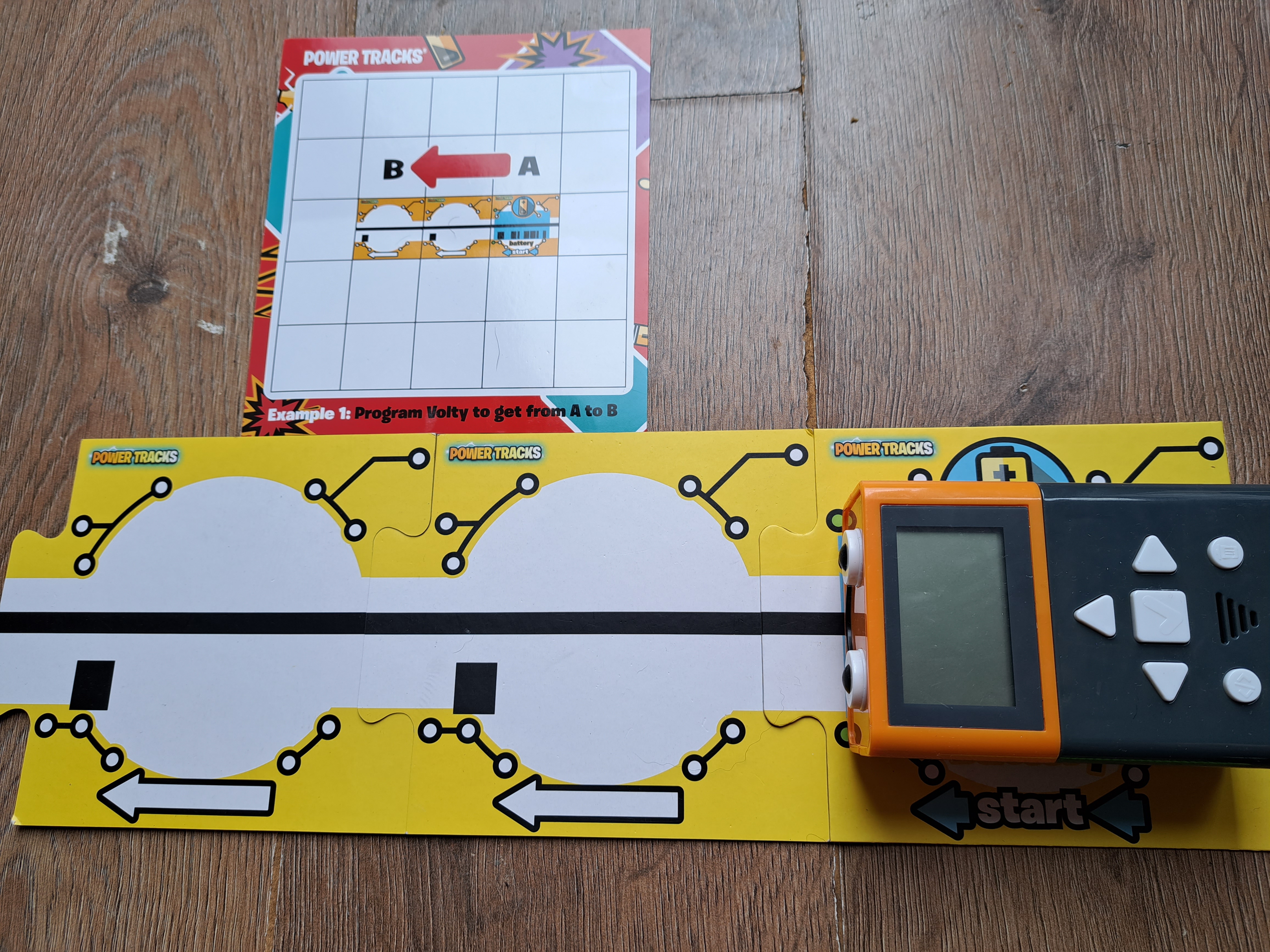
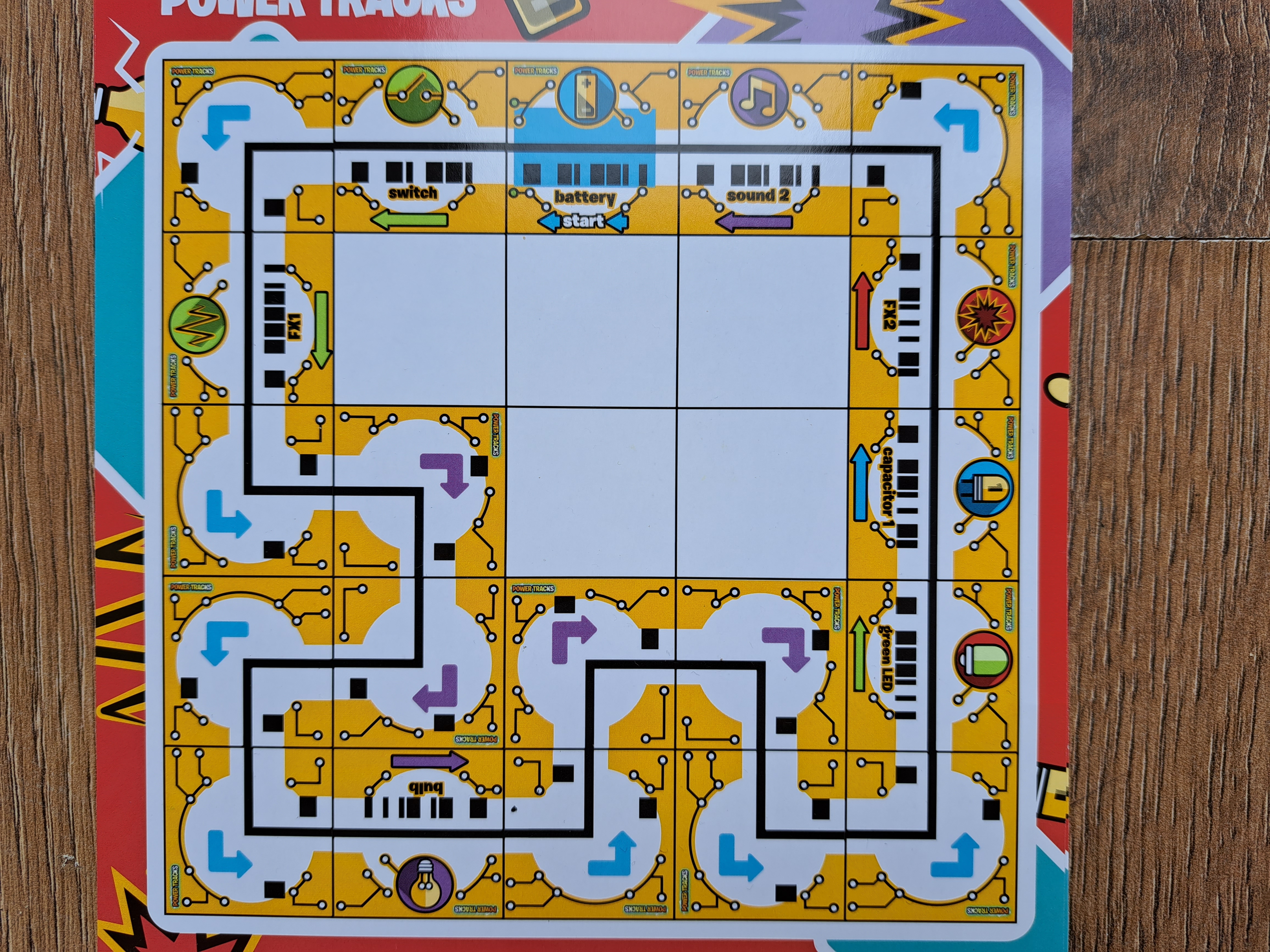
-Robotics: "Micro:bit Robot Car (KS4036F)" from Keyestudio.
Players: 1
Recommended ages: 1.5+ years
Time to play: 5-10 hours
Paid: £33 from Keyestudio (I received for free in exchange for my feedback)
This kit comes with everything (minus the batteries and actual Micro:bit) to construct a robot car. The instruction
manual shows how to put the components together. Building the car took less than 20 minutes. The codes (in MakeCode,
javascript, and Python) for using each component are included and explained. The
car is meant to track a line, track an object, avoid an object, track a light source, display colorful LEDs, and move in
response to a remote control, Bluetooth, and downloadable App. The car did a great job at many of the above features,
but I could not get line tracking, Bluetooth, or the downloadable App to work. Light tracking was my favorite part of
the car. The Micro:bit itself is incredibly powerful and has built-in compasses, accelerometers, geomagnetic sensors,
microphones, speakers, etc. I think this kit might be a good introduction to electronics, especially if the user is
worried about building the car. I preferred the bigger Micro:bit car KS4034F, however, as all of the functions in that
kit's car worked.
Pros: Clear instructions on how to build and use the car. Car runs off 3xAAA batteries (easier to source than 18650
batteries). Interesting desk talking piece. Enjoyed light tracking!
Cons: Micro:bit not included in kit. Some features did not work. For price difference, I'd prefer the bigger model.
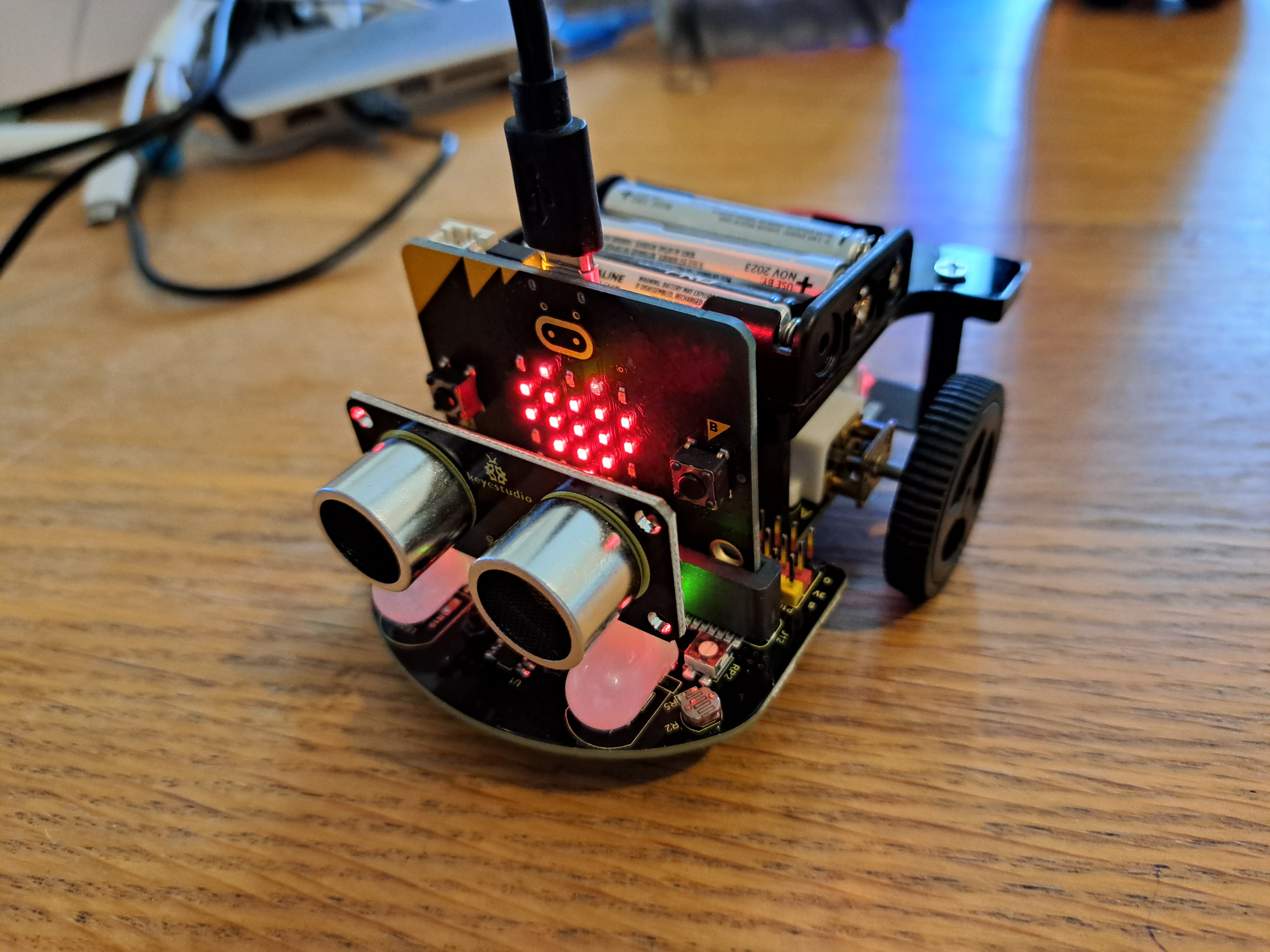
Other Robotics Games/Activities: "Botley The Coding Robot" from Learning Resources UK, Similar Robot Car from Elegoo,
"Kids First Coding & Robotics" from Thames & Cosmos.
M: Mathematics
At this age, Mathematics focuses on addition/subtraction at the younger end of the age bracket - and on
multiplication/division, fractions, exponents at the older end of the age bracket. I have selected
a few games below which fit these skills. Flash cards, online maths games (even Duolingo now), wipe-clean
erase workbooks are other options children may enjoy. If you want a specific game, it may need to be bought
new and the games can be quite expensive. Charity shops generally have second-hand mathematics games or
flash cards for sale at a much lower price.
-"Magic Maths" by Orchard Toys.
Players: 2-4
Recommended ages: 5-7 years
Time to play: 15+ minutes
Paid: 50p from Charity Shop
Competitive game. Each player is a wizard. Half the cards show equations on one side (mostly addition/subtraction
with some multiplication) and stars on the other side
(star side is shown initially). The other cards have a single number on one side and a spell ingredient on the other
side (number side shown initially). Each player selects a star card, looks at the equations, says what
they think the answer is, and rubs the star to reveal the correct answer. If the player said the correct
number, the player collects the answer card and turns it over to reveal the spell ingredient he/she has won.
First player with six spell ingredients wins!
Pros: Younger kids really like wizard theme. Great that correct answers are provided (under star) so kids don't
need to verify answers with adult. Wizards are different genders and skin tones to represent more kids. The spell
ingredients are fun for kids (smelly shoes, eye balls, etc). Nice chunky cards. Game can easily be found in charity
shops for reduced price.
Cons: The reveal stars don't work as well after a lot of play. Theme is bit baby'ish for older primary school children.
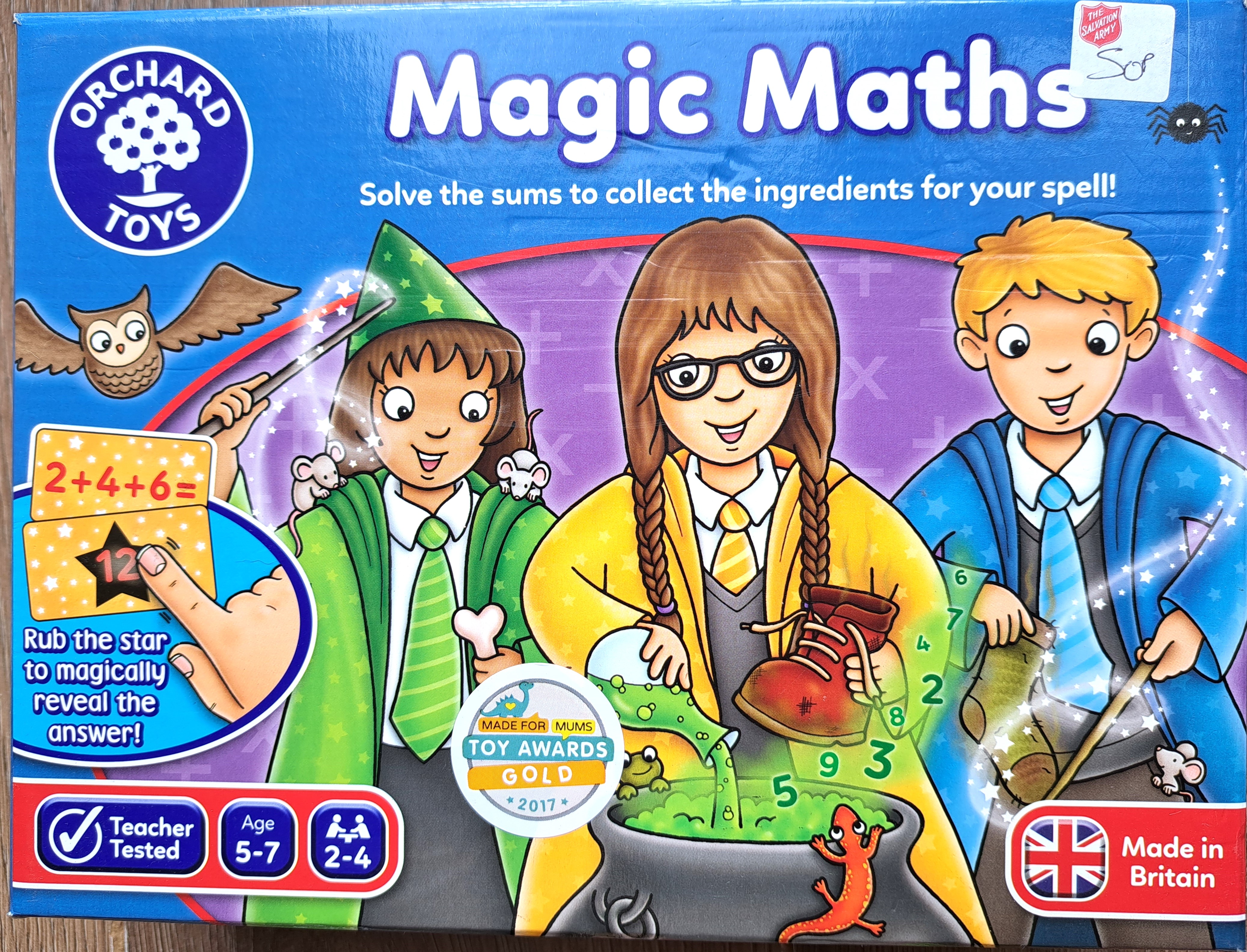
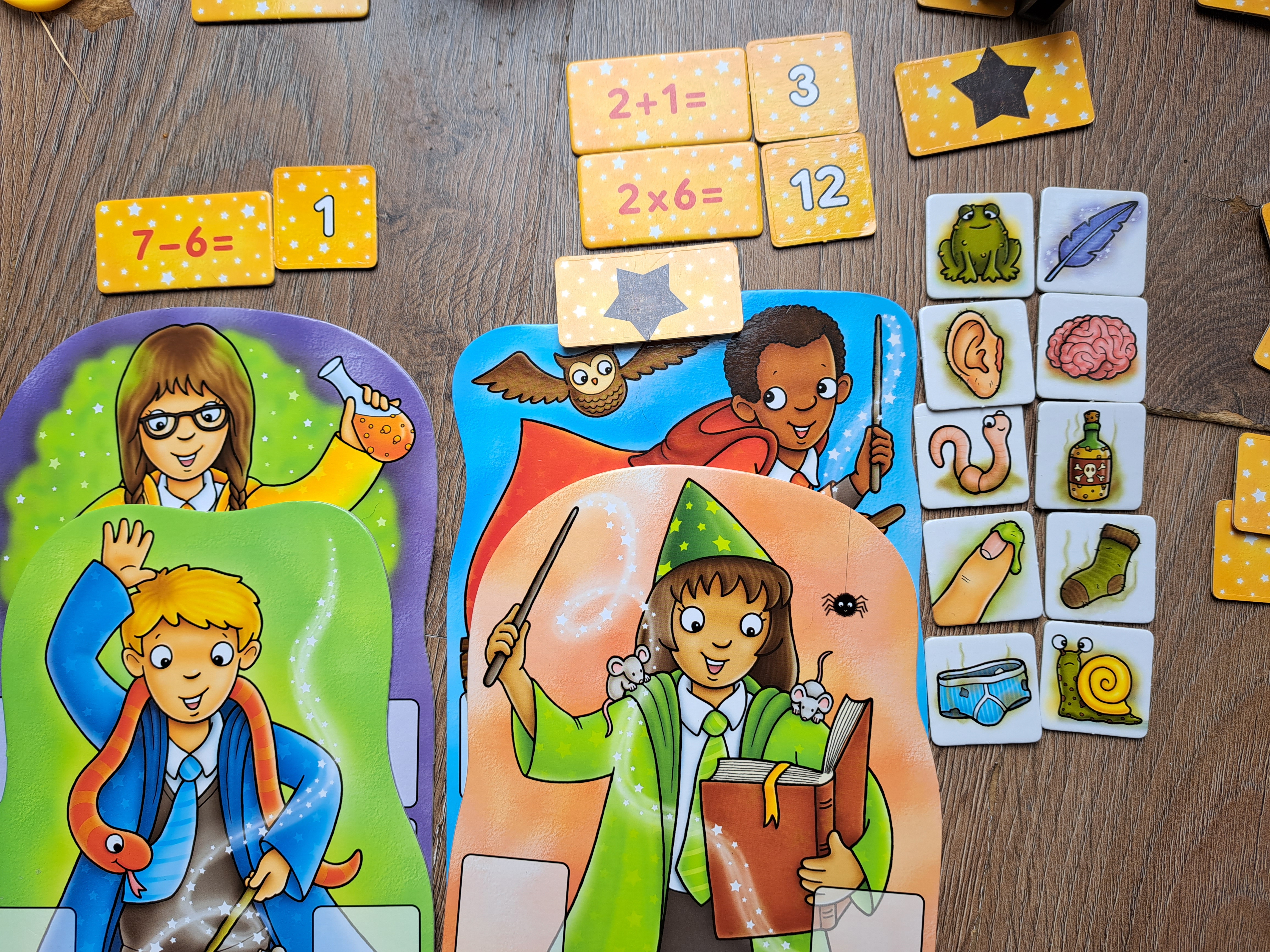
-
"Outnumbered" by Genius Games.
Players: 1-6
Recommended ages: 4+ years (training mode), 8+ years (full mode)
Time to play: 20+ minutes
Paid: £20 from Steam Rocket (I received free from Genius Games for a game review - this is my own opinion with no
influence from Genius Games)
Cooperative game. Roll dice to defeat villains! Each villain has a number, and you add/subtract/multiple/divide/power
the numbers on the rolled dice to match the numbers on the villains. If they match, the villains are defeated! Game
has training mode with smaller numbers for younger players.
Pros: Brilliant theme - my kids love being superheroes and defeating villains! I love cooperative games! Simple to
understand and play. Good
replayability. We use this as maths practice during school holidays or illnesses. Great artwork. Fun for kids and
adults.
Cons: Cards are a bit flimsy for younger kids who absentmindedly fold them up. Need adult supervision to ensure
kids are doing mathematical calculations correctly.
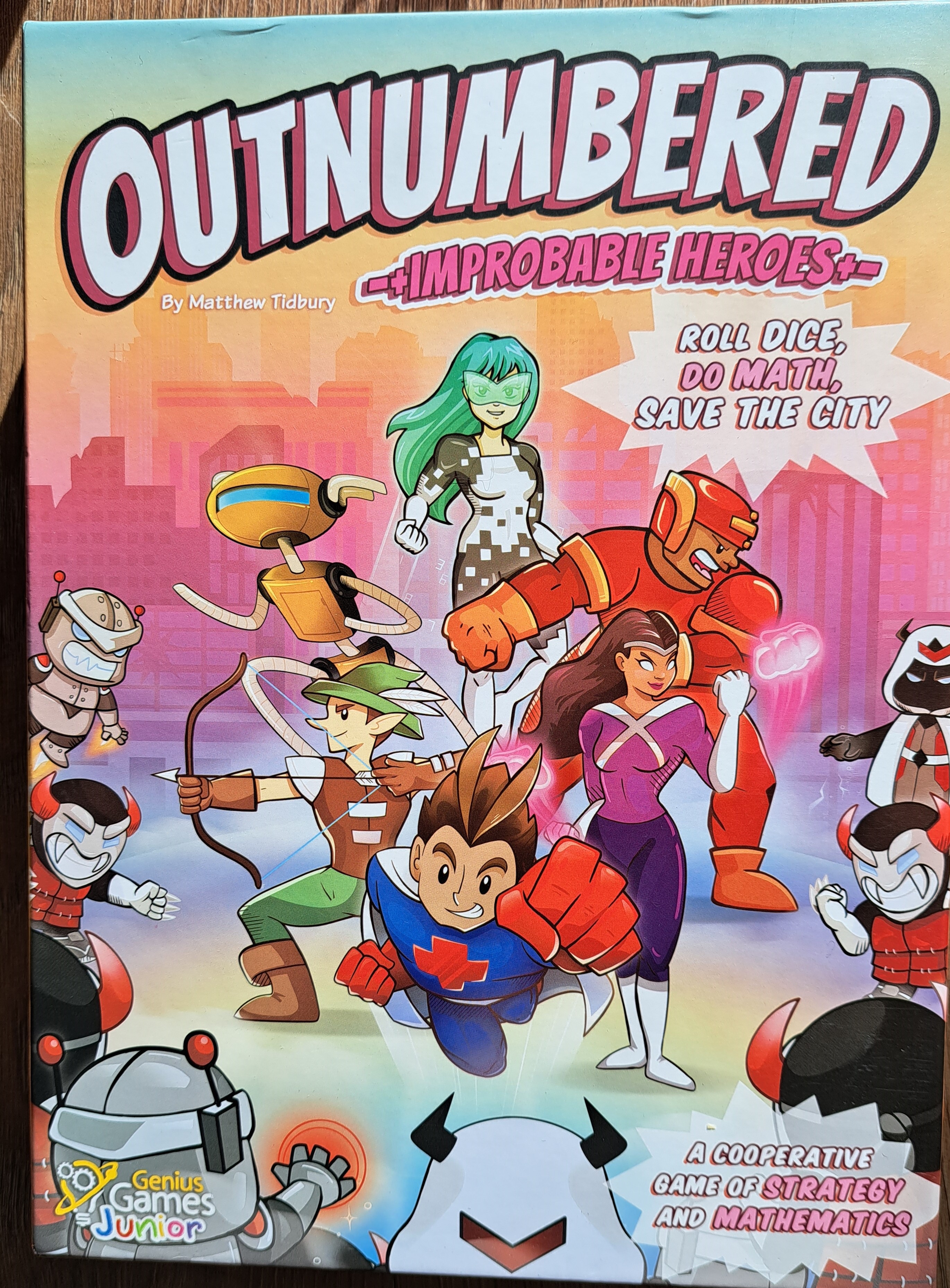
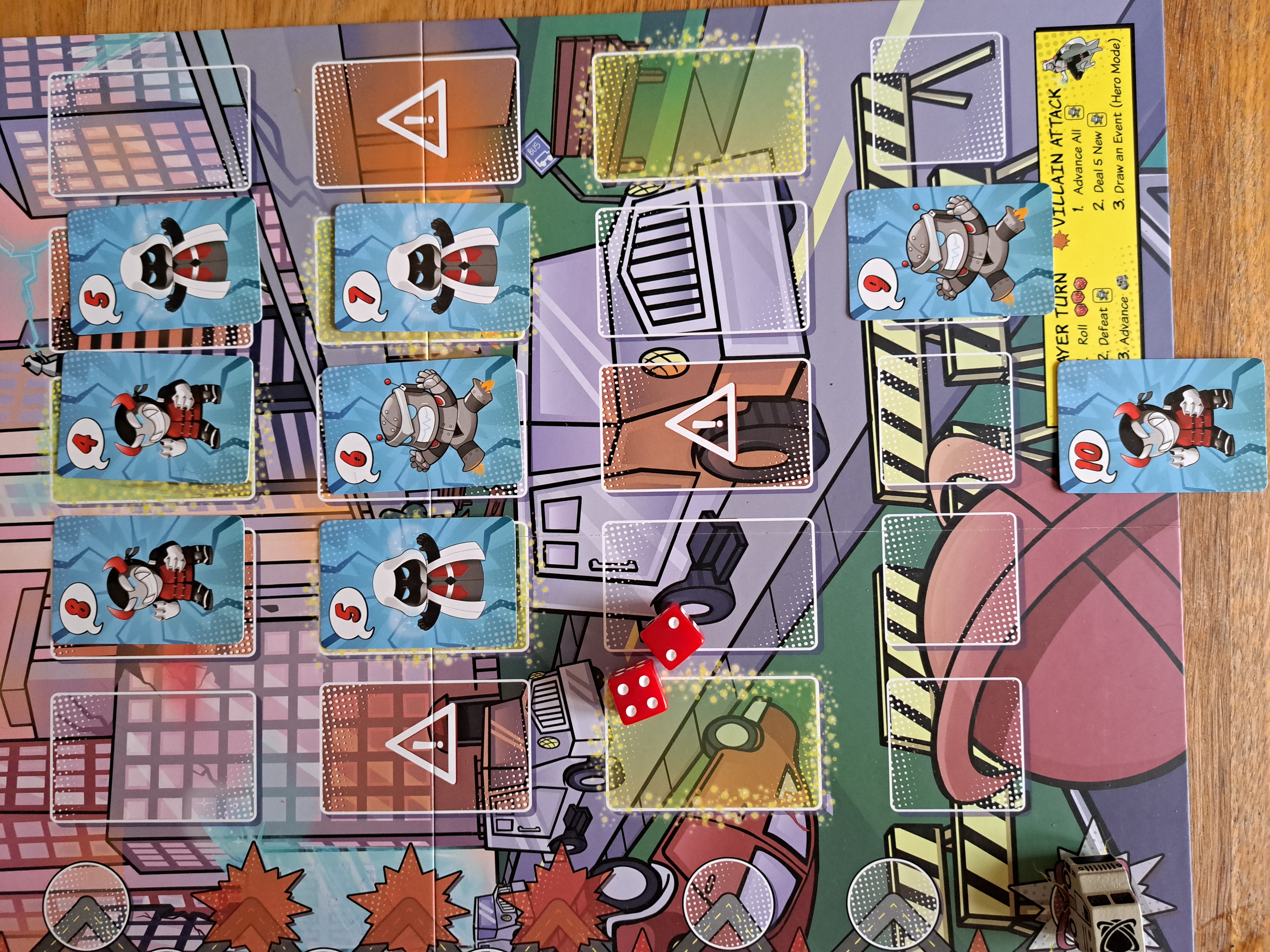
-"Numbers League: Adventures in Addiplication + Expansions (Fractions)" by Bent Castle Workshops. .
Players: 2-4
Recommended ages: 8+ years
Time to play: 30+ minutes
Paid: £19 from Mad Hatter Board Games (for base game and expansion)
Cooperative game. Cards have superhero head, chest, and leg cards, each with a number. You combine one of each to create
your hero, and if the combined number matches the number on a villain, you defeat the villain!
Pros: Great theme - we love superheroes and cooperative games. Fun to combine different heads, chests, and legs to
make funny-looking superheroes. Great way to teach mathematics skills!
Cons: Game is more complex than Outnumbered so for older age range. Harder to mentally add 3 numbers than 2 numbers as
in Outnumbered (this seems to be a good next game after kids outgrow Outnumbered). Game requires a lot of space.
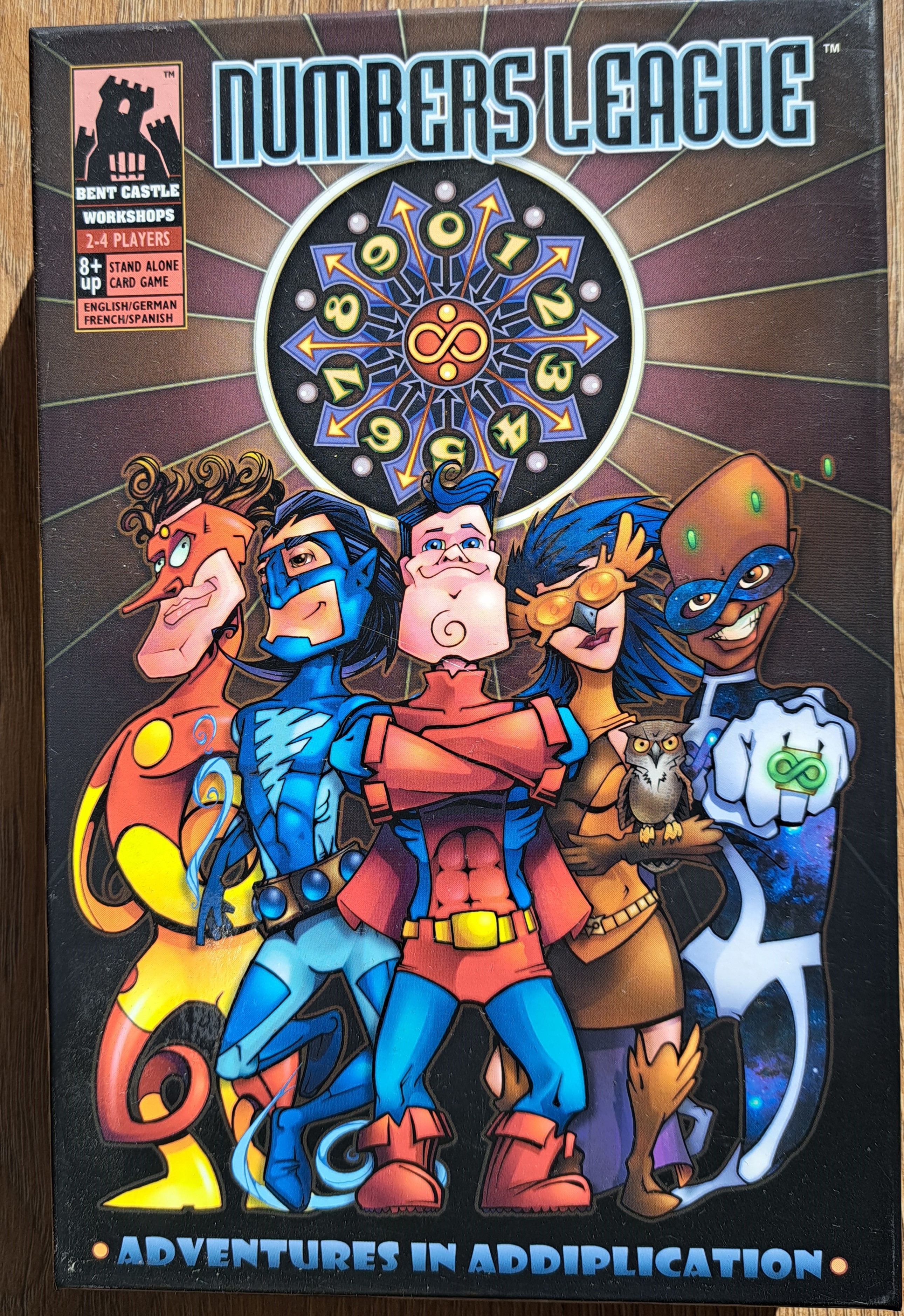
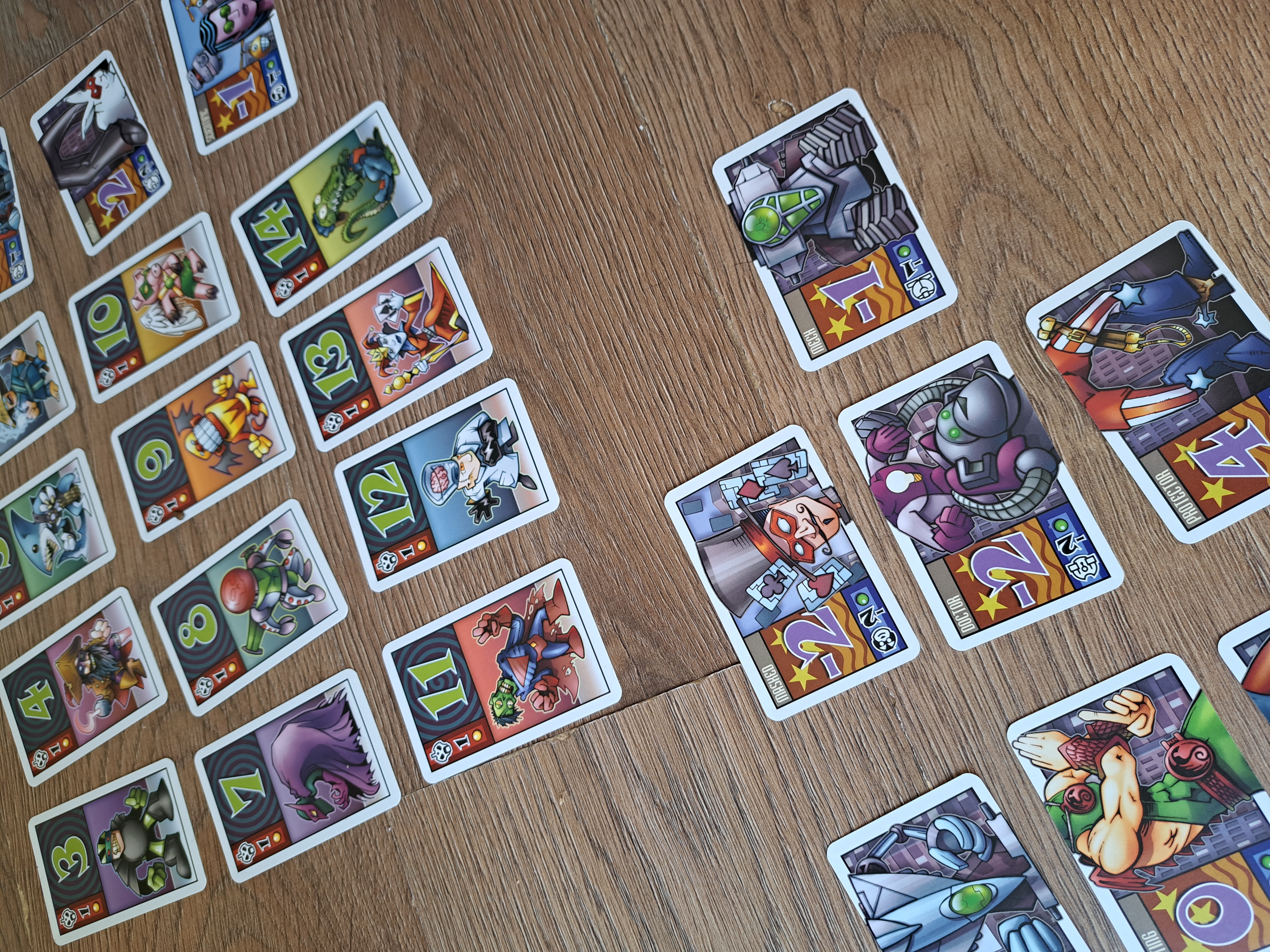
Other Mathematics Games: "City of Zombies" from Genius Games; "Prime Climb" from Thinkfun; "Money Match Cafe", "First Times Tables",
and "Times Tables Heroes" all from Orchard Toys
This website was created in October 2023 based on what was available at the time and what my children have enjoyed. There will doubtless be other games and activities you have also enjoyed. Please leave comments on the YouTube video above if there is something you think should be added to the list. Thank you for reading!
Other Articles:
Mars Re-EntryA ThreeJS simulation of Mars re-entry in a spaceship. |

|
AtmosphereA simple demo of a simulation of an atmosphere. It looks quite cool, but there's not a lot you can do with it yet, and the physics isn't yet all that accurate. |

|
